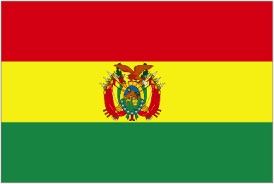
Bolivia – Trackchasing Country #80

Trackchasing Country #80
Greetings from places on the way to Santa Cruz, Bolivia (Part 1) and later La Paz, Bolivia (Part 2),
Click on the links below to read about and see the photos and videos from my visit to first Santa Cruz and then Pucarani (La Paz), Bolivia. Yep. I was visiting the South American country of Bolivia home to almost 11 million people. ……trackchasing country #80.

LIKE TO KNOW MORE ABOUT BOLIVIA – TRACKCHASING COUNTRY #80?
As a service to my readers I always provide a top line background of each country I visit. If you’d like to learn a little more about the history and the people of Bolivia check out the “background” information I prepared for you. It appears at the bottom of this report. I have condensed this section so you can get a good “feel” for this landlocked country’s history. Most of the material comes from Wikipedia. We can trust them.
PRE-TRIP
Advance Preparation
I have obviously done my share of world traveling with and without my hobby of trackchasing. I’ve had some of the most unusual experiences that a person could possibly have.
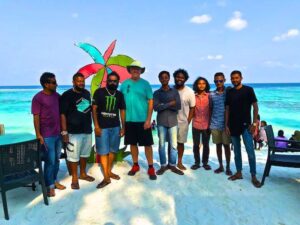
Last month I went to Maldives. I made my final decision to go there just 10 hours before the flight left Los Angeles. My trip planning for Bolivia began more than a year ago.
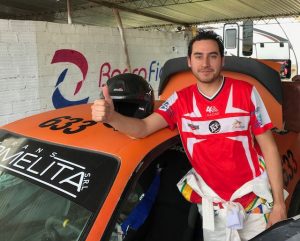
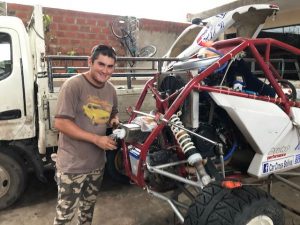
I can’t do this without help from people who live in the countries I visit. Sergio Kosky (above left) was the first Bolivian I met as I began to research a possible visit to Bolivia. Sergio races at Autodromo de Pucarani. A little bit later I ran into Manolo Chavez (above right). Manolo is a racer at the Autodromo Santa Cruz. Both of these amigos would help me finalize my trip.
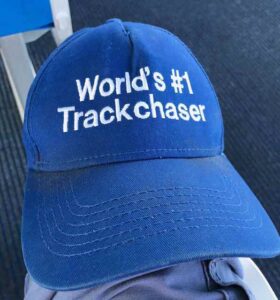
Randy Lewis Racing Research Department
Up to this point I have seen racing in 79 of the 195 countries recognized in the world. There are only ten or twelve countries, maybe less, that have racing where I had not visited.
However, the Randy Lewis Racing research department discovered racing in Maldives when nobody else thought there was any racing at this island nation. If that can happen how many other countries, where no one knows about racing, can actually have wheel to wheel racing. I will tell you this. I’m glad I have the Randy Lewis Racing research department on my side. My fellow competitors, with much less robust research capabilities, can go to these places after I’ve told them all about it!
Both Sergio and Manolo had extended an “open arms” invitation to visit Bolivia. They each had different “products” to offer however.
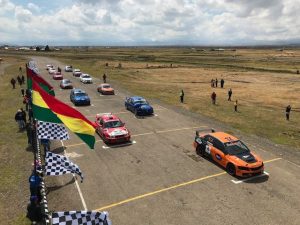
Sergio wanted me to visit the Autodromo de Pucarani. It’s an established permanent circuit track. That sounded good. However, there was one significant watch out. That track was located at an elevation of 14,000 feet. There is not 1% of the world’s population that have ever been at that elevation…outside of an airplane!
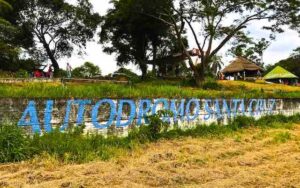
On the other hand Manolo was offering a trackchasing visit to Santa Cruz, Bolivia. His track opportunity, also a circuit track but with a dirt surface, was at a much more modest elevation of about 1,500 feet above sea level. By the way, back home in our sleepy little town of San Clemente, California our elevation is 114 feet.
It was nice having two options. Over the past year I have exchanged hundreds of messages back and forth with these two Bolivians. I’ve even spoken with their relatives located in the U.S. Yep. When I visit these foreign countries I do whatever it takes to insure foreign country trackchasing success.
THE RACE
I really had never decided for sure which of these two tracks would be the first to represent Bolivia for me. I figured the first track to have a race date that would fit my intense worldwide trackchasing schedule would get the nod.
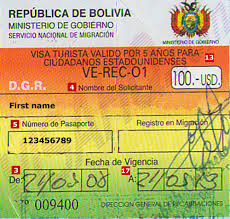
I sort of felt an obligation to visit both tracks. As you will see below I have a 10-year visa to Bolivia. There would be plenty of time to come back to Bolivia to pick up that second track if I wanted to do that.

Not very many trackchasers have ever trackchased outside of the U.S. or Canada. Of those that have not many have ever seen racing at more than one track in the foreign countries they have visited. Seeing racing at more than one track is common place for me in countries other than the U.S. Here’s a list of countries where I’ve seen two or more tracks.
Australia
Austria
Belgium
Canada
Denmark
France
Germany
Hungary
Ireland
Italy
Malta
Mexico
Namibia
Netherlands
New Zealand
Turkey
Ukraine
United Kingdom
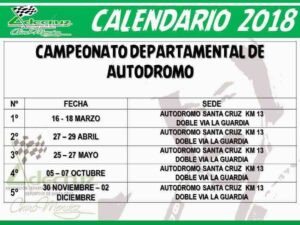
Manolo, representing Santa Cruz, was the first to send me his group’s 2018 circuit racing schedule. The late April date (29 April) looked like that would work. Once I had made a commitment to that race Sergio sent me their Pucarani race schedule. They had a race a week later. Perfecto!
I could go to the Santa Cruz race on 29 April. Then I could tour Bolivia for a week. I would close the trip seeing racing at Autodrome de Pucarani the very next Sunday, 6 May.
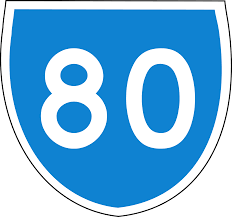
When this trip is finished I will have seen racing in 80 countries. In most of those countries I was only able to see one track each weekend. When I decided to head to Santa Cruz I bypassed a four track weekend in the American south.
On a normal trackchasing weekend I will see 3-4 new tracks. I estimate that I have been able to see only one track during a weekend in about 65 of the new countries I have visited. That means I have had to pass up somewhere between 150-250 American tracks when trackchasing in new countries. Add those numbers to the hundreds of tracks I passed up because we had three wonderful children to follow during the growing up years and that’s LOTS of tracks I didn’t see. However, life is a tradeoff. I wouldn’t have changed a thing.
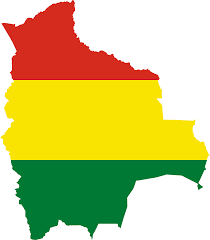
The Bolivian trackchasing plan was in place. I would see racing at Autodromo Santa Cruz in Santa Cruz on 29 April. A week later I would find myself at the Autodrome Pucarani on 6 May.
THE VISA
Some countries require visas for U.S. visitors and some do not. The more “foreign” the country the more likely that I would need a visa. I guess Bolivia was a very “foreign” country. They did require a visa.

As a matter of fact, I needed to get the visa before I left for Bolivia. It was going to cost me too. Bolivia charges U.S. citizens $160 USD for a 10-year unlimited visit visa. That wasn’t great but a Russia visa will set you back more than that for just one visit!
I applied for my Bolivian visa back in mid-2017. I didn’t know when I would be visiting but I suspected the trip might happen on short notice. If it did I would be ready.
I would have to mail my passport into the Brazilian consulate office in Los Angeles. That was after I had completed all of the “paperwork” online and sent that in. That included sending in an electronic photo as well.
I would be without my passport for about a week. I didn’t like that idea. I leave the country nearly 10 times a year. I spend a month or two out of the country in most years. Many of my trips are planned on a day or two’s advance notice. When an international travel opportunity comes my way I can’t have my passport sitting in a foreign countries consulate office. When the word comes I gotta go and I need my passport!
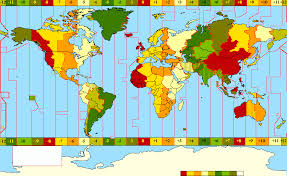
TIME ZONES
This is what Wikipedia has to say about Bolivia and its time zone.
UTC−04:00is a time offsetthat subtracts 4 hours from Coordinated Universal Time(UTC). It is observed in the Eastern Time Zone(e.g., Canadaand the United States) during the warm months of daylight saving time, as Eastern Daylight Time. The Atlantic Time Zoneobserves it during standard time(cold months). It is observed all year in the Eastern Caribbean.
BOOTS ON THE GROUND
I could trackchase internationally all day long without any help from anyone on the ground in the countries I visit. It’s just that I couldn’t do it very well. With the help of local people a very basic trip becomes an adventure. To get the most out of each of these trips I really need someone in the country I am visiting to guide me in the right direction.

I did have help from a couple of Bolivian racecar drivers. However, the language barrier, they spoke Spanish and I only spoke English was a bit of an issue. They helped me with race date information and the like. I needed more advice on how best to enjoy Bolivia.
As always I went to TripAdvisor for touring help. However, the country of Bolivia doesn’t have an in-depth presence at TripAdvisor. As an example, Argentina has 232,398 posts and Peru (likely because of Cusco) has 225,162 posts while Brazil comes in third at 170,964 messages on TripAdvisor respectively. Bolivia has only 14,772 messages. People just aren’t talking about Bolivia. Why is that? Because not many folks are traveling to the country.
TripAdvisor notes did direct me toward Banjo Tours, a Bolivian travel agent. This company didn’t work all that well for me. Their back and forth communication was a bit slow. When I do this I need immediate feedback. Time is on the essence.
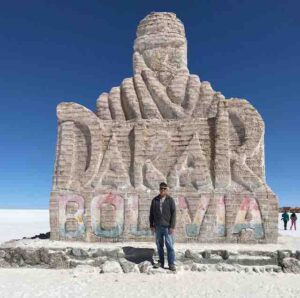
Banjo Tours organized trips to the Salar de Uyuni salt flats among other things. The #1 tourist attraction in Bolivia is a trip to the salt flats. These folks sold tours for up to six people. If six people came on the tour a trip for three days and two nights might only cost $400 USD or so per person. If one person went the trip would cost $1,500-2,000 USD for that single traveler! I was negotiating for a trip that I thought might cost me $400 USD. Then at the last minute they told me that I was the only person signed up. I could do the trip for $2,000 USD. No thanks, Banjo Tours.
Next up I did some searching around on my own. I came up with the Kim Kim travel group located in Bolivia. A young woman named, Lucia, would be my contact.
I told her what my racing commitments were. I told her when I could tour in between those race dates. With that limited amount of information Lucia grabbed the bull by the horns and came up with a wonderful touring plan. As it all unfolds I will tell you all about it.
I can say this. If you plan to visit and tour Bolivia then Lucia from the Kim Kim travel group should be your travel agent. I’ve worked with a lot of people in the travel arena over the years. Lucia is at the top of the list with a few others as a creative travel advisor. Well done Lucia.
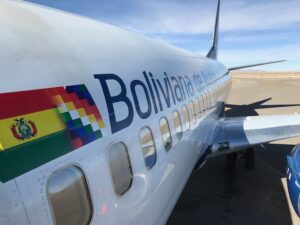
THE TRANSPORTATION
The transportation, i.e. how do I get there and back in always a most interesting and challenging part of these trips. Bolivia was going to be extra interesting!
To begin with I would fly from Los Angeles, California to Ft. Lauderdale, Florida (FLL). Of course, that would be an overnight flight. When I landed in FLL I would take a couple of buses and a train over to the Miami International Airport (MIA). My layover in Miami would be about 17 hours.
From MIA I would fly overnight for a second straight night to La Paz (LPB), Bolivia on American Airlines. Although I would come back to LPB later in the trip I would only stay in LPB for an hour before the flight took to the air again bound for Santa Cruz (VVI), Bolivia. I would be in Santa Cruz for four nights.
In the middle of my visit I would catch a flight from Santa Cruz to Sucre. From Sucre I would ride a bus for five hours to Potosi. The next day I would be on another bus for four hours to Uyuni. Then the next day I would catch a flight from Uyuni to La Paz. Still with me?
After a couple of days in La Paz, I would hop on a flight to Santa Cruz. There I would pick up a flight to Miami. From Miami I would fly back to Los Angeles.
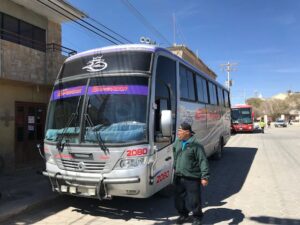
The trip would include eight flights. I would have at least four bus rides. There would be a train, several shuttle buses, some cable cars and a host of private drivers moving me from point A to B to C, etc. Now THAT’S a transportation plan!
By the way during the planning process for this trip I encountered a concept called “cobatage”. Ever heard of cobatage? No, I didn’t think you had. Son J.J. is the only person I personally know that knew what cobatage was.
“Cobatage” happens when a foreign air carrier operates a flight that both takes off and lands in another country. I wanted to book a flight on American Airlines that was departing from La Paz, Bolivia and landing in Santa Cruz, Bolivia.
Wouldn’t you know it? American Airlines has some interesting routes as one of the biggest worldwide airline carriers in the world. As far as industry experts can tell, the LPB-VVI flight is the onlyscheduled American Airlines flight that doesn’t takeoff or land in the United States. I guess I was just lucky to find this one and only flight. As a matter of fact, after 26 years, this flight was being discontinued in July, 2018. Yes, I would be making this trip just in time!
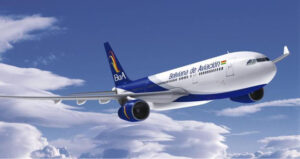
This trip would have me flying for about 13-14 hours….each way. The flight miles would exceed 12,000 miles. This is what my flight travel itinerary looked like.
Los Angeles, California – Ft. Lauderdale, Florida – 4H50M – 2,342 miles
Miami, Florida – La Paz, Bolivia – 6H45M – 3,020 miles
La Paz, Bolivia – San Cruz, Bolivia 1H25M – 343 miles
Santa Cruz, Bolivia – Sucre, Bolivia 0H45M – 170 miles
Uyuni, Bolivia – La Paz, Bolivia 0H45M – 286 miles
La Paz, Bolivia – Santa Cruz, Bolivia 1H25M – 343 miles
Santa Cruz, Bolivia – Miami, Florida 7H5M – 3,201 miles
Miami, Florida – Los Angeles, California 6H10M – 2,342 miles
I would be gone from home for thirteen days and twelve nights. The above flight schedule would cover right around 12,047 air miles. That might seem like a lot until you consider that my total travel mileage (rental car and airlines) in any given year is 200,000-250,000 miles. In the first four months and a week of 2018 I will have logged about 85,000 miles for the year.
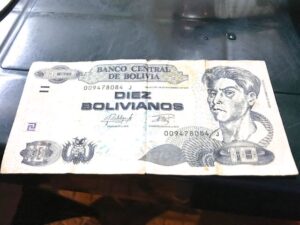
CURRENCY
Carol is my international currency dealer. However, she couldn’t help me with Bolivian currency. She didn’t have any Bolivian Boliviano in her stash. I would have to get those in country.
Here’s what I knew about the Bolivian money situation. One U.S. dollar would buy me 6.91 Bolivian Bolivianos. I had a good supply of U.S. dollars. I would be able to use credit cards for my flights, buses, private drivers and hotels. I figured I would change money along the way. Most foreign countries have a myriad of currency exchanges all over the place. I would try to use credit cards but when I couldn’t for meals, tips and the like I would use the local currency.
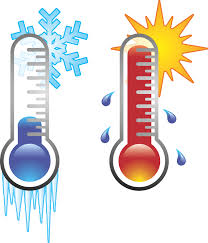
WEATHER
When I trackchased in Belarus in February the temperature was about 10 degrees Fahrenheit. In March when I went to Maldives the daily high temperature was 90 degrees. Those was pretty large swings in temperature.
My time in Bolivia would have a little of both of the above. In Santa Cruz the daily high temperature would be just like Maldives, about 90 degrees Fahrenheit. However, in La Paz and most of the mid-week touring sites I would visit the temperature would only reach about 60 degrees. In those locations the overnight lows would go down to about freezing or 32 degrees Fahrenheit. What did that mean? I had to dress for nearly the exact weather I had experienced in first Belarus and then Maldives. However, my warm weather and cold weather wardrobes would both need to be carried to Bolivia!
OVERNIGHT ACCOMMODATIONS
I mentioned I would be gone for 12 nights. That makes for a pretty long foreign trip. However, as you read along you’ll see why it all made good sense.
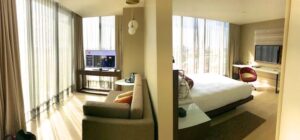
I would spend the first four nights at the Marriott hotel in Santa Cruz, Bolivia. Those were the first four HOTEL nights. The first two nights of the actual trip would be spent flying overnight on airplanes. It’s rare that I take red-eyes for two consecutive nights. I’d like to keep it that way.
The Marriott worked well because of my loyalty program status with them. I am a “platinum elite”. That would get me an upgrade, maybe to a suite, complimentary breakfast, free Wi-Fi, a welcome gift, admission to their private hotel lounge and free cocktails and hor’dourves. It might have been fun to stay at a local Santa Cruz hotel but with all of the Marriott perks, at a reasonable price, I couldn’t pass on the Marriott.
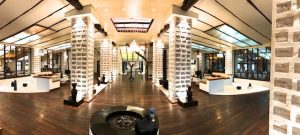
The next four nights would be at very unique authentic Bolivian hotels, including the world’s first ever salt hotel! These hotels were all at very high elevations. More on that fact later. I would finish the trip with a couple of nights in La Paz, again at most unique Bolivian hotels.
THE RENTAL CAR
No rental car for me on this trip. I would have a series of private drivers moving me from airports to hotels to bus stations. I would take two long distance over the road Bolivian bus rides. I was looking forward to that. Bolivian highways were reported to be in bad shape. I wanted to see how bad the roads really were. I passed on an overnight, 10-hour bus ride and decided to grab an airplane ride instead when heading to La Paz toward the end of the trip.
NAVIGATION
I wasn’t driving. I would trust my drivers even though most of them would be “Spanish speaking” only. I don’t speak Spanish. I had two years of high school Spanish but I only passed the course because I was a basketball player. Growing up in Illinois in the 60s did not give me much exposure to the Hispanic culture. As a high school kid I never dreamed I would travel to places where Spanish was spoken. I guess I was wrong about that.

THE TRAVELING COMPANION
I don’t want you to get the wrong impression. I don’t exclude Carol from any trip I take. It’s just that I take a LOT of trips. Carol is more of a home body. My secret goal for her travel is to get Trackchasing’s First Mother (yes, that’s Carol) on the road overnight for 80-100 nights a year. Now I don’t want you to TELL her that. We’ll just keep that between you and me O.K.? Since she doesn’t read my reports I can share stuff like that without fear of her finding out what my secret goals for her are right?
Through the first four months of the year Carol has traveled 26 nights. That’s nearly a month of travel in just four months. For just about anyone that’s a lot of travel especially for a professed homebody.
Carol has agreed to three big trackchasing trips for the rest of the year. I’m talking 1-2 week trips. She won’t see a lot of tracks on those trips but she’ll see the world! Of course, she’ll go back to Hawaii, visit the grandkids in Texas and try to fend off even more travel ideas I will float her way. If I had to guess she’ll be at about 80 travel nights for the year. If that happens I will consider things a success!
By the way Carol does get invited on every trip. I don’t know what I would do if she accepted each invitation! However, I don’t think I have to worry about that.
In the first four months of the year Carol has already spent nearly a week in New Orleans with me celebrating our wedding anniversary. A couple of weeks ago we got back from an eight-night Western Caribbean cruise. Then we spent eight days in Maui, Hawaii. She went to Denver for four days to visit her mother and sister. We just got back from grand baby babysitting trip to Texas. She’s been busy especially when you consider she takes care of EVERYTHING at home. Heck, I don’t even know what day trash pickup is….and I’d like to keep it that way.
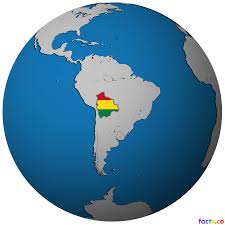
THE SUMMARY
Bolivia here I come! I first started thinking about a trip to Bolivia more than a year ago. I got my Bolivian travel visa ($160 USD) last summer. How many other visas are bought and paid for and ready to use when the time is right? Sorry, that’s confidential information. I didn’t know exactly when I would make the trip to Bolivia. I figured I had some time. My travel visa was good for unlimited visits over the next ten years.
Like most of my travel plans once I get the trackchasing “go-ahead” things happen quickly. I plan the best I can with the time and information I have. Then I just go for it.
I think it’s fair to say that most people are not as adventuresome as I am when it comes to travel. That’s not a criticism of anyone. It’s just an observational fact. I get a kick out of this or I wouldn’t do it.
Like most, O.K. all of these trips, I have things I want to get done. If I accomplish these three things on this trip I’ll be happy. It is the race that brings me to these countries. Yes, I want to see a race. I’ll want to see new things as well. That’s not hard to do. If I haven’t been to a country everything I see is new! Finally, I’ll want to meet new friends. I can be a pretty outgoing guy. I learned to do that by being in sales for most of my career. I’m looking forward to meeting several Bolivian natives. I’ll do my best to make this a memorable trip.
My “world map” has filled up surprisingly quickly. However, there are “agents” working as you read this on new trackchasing countries to visit. I appreciate every one of their contributions. Here’s where I’ve been so far.
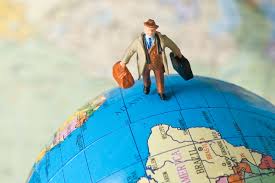
RLR – Randy Lewis Racing Lifetime Trackchasing Countries
# 1 – UNITED STATES OF AMERICA – Peoria Speedway – Mt. Hawley (oval) – Track #1, Peoria, Illinois – circa 1955
# 2 – CANADA- Cayuga Speedway (oval) – Track #174, Nelles Corner, Ontario – 1988
# 3 – AUSTRALIA– Parramatta City Raceway (oval) – Track #180, Granville, New South Wales – 1989
# 4 – UNITED KINGDOM– Northhampton International Raceway (oval) – Track #378, Northhampton – 1999
# 5 – NETHERLANDS– Driesum Racetrack (oval) – Track #839, Driesum – 2005
# 6 – BELGIUM– Bellekouter oval (oval) – Track #841, Affligem – 2005
# 7 – FRANCE– Circuit de Croix en Ternois (road course) – Track #843, Saint-Pol sur-Ternoise – 2005
# 8 – GERMANY– Nurburgring (road course) – Track #844, Nurburg – 2005
# 9 – NEW ZEALAND– Western Springs Speedway (oval) – Track #1,134, Western Springs – 2006
# 10 – MEXICO– Triovalo Bernardo Obregon (oval) – Track #1,281, Tiajamulco de Zuniga, Jalisco – 2007
# 11 – BARBADOS– Bushy Park Racing Circuit (road course) – Track #1,296, Bushy Park- 2007
# 12 – THAILAND– Bira Circuit (road course) – Track #1,300, Pattaya – 2008
# 13 – SOUTH AFRICA– Durban Grand Prix (road course) – Track #1,315, Durban, KwaZulu-Natal – 2008
# 14 – JAMAICA– Dover Raceway (road course) – Track #1,322, Brown’s Town St. Ann – 2008
# 15 – SWEDEN– Sturup Raceway (road course) – Track #1,335, Malmo – 2008
# 16 – DENMARK– Ring Djursland (road course) – Track #1,336, Tirstrup- 2008
# 17 – CZECH REPUBLIC– Automotodrome BRNO (road course) – Track #1,381, Brno – 2008
# 18 – AUSTRIA– Lambrechten Stock Car Track (road course) – Track #1,382, Lambrechten – 2008
# 19 – IRELAND– Tipperary International Raceway (oval) – Track #1,388, Rosegreen – 2008
# 20 – GUYANA– South Dakota Circuit (road course) – Track #1,390, Timehri – 2008
# 21 – CHINA– The Guia Circuit (road course) – Track #1,392, Macau – 2008
# 22 – COSTA RICA– Autodromo La Guacima (road course) – Track #1,398, La Guacima – 2008
# 23 – ANDORRA– Grandvalira Circuit (road course) – Track #1,404, Port d’Envalira – 2009
# 24 – ARGENTINA– Circuito Efren Chemolli (oval) – Track #1,406, Buenos Aires – 2009
# 25 – QATAR– Losail International Circuit (road course) – Track #1,408, Doha – 2009
# 26 – BAHRAIN– Bahrain International Circuit (road course) – Track #1,410, Sakhir – 2009
# 27 – UNITED ARAB EMIRATES– Dubai Autodrome (road course) – Track #1,411, Dubai – 2009
# 28 – COLOMBIA– Autodromo de Tocancipa (road course) – Track #1,415, Tocancipa – 2009
# 29 – SPAIN– Motorland Aragon (road course) – Track #1,416, Alcaniz – 2009
# 30 – PORTUGAL– Circuto de Murca (road course) – Track #1,417, Murca – 2009
# 31 – ICELAND– Kapelluhraum (road course) – Track #1,420, Hafnafjorour – 2009
# 32 – HUNGARY– Hungaroring (road course) – Track #1,426, Mogyorod – 2009
# 33 – SWITZERLAND– Hock Ybrig (road course) – Track #1,427, Hoch Ybrig – 2009
# 34 – ITALY– Vighizzolo d’Este Stock Car Track (road course) – Track #1,428, Vighizzolo d’Este – 2009
# 35 – DOMINICAN REPUBLIC– Autodromo Mobil 1 (road course) – Track #1,515, Santo Domingo – 2009
# 36 – MALTA– Ta’Qali Race Track (road course) – Track #1,521, Ta’Qali – 2010
# 37 – FINLAND– Lake Pidisjarvi Ice Track (road course) – Track #1,524, Nivala – 2010
# 38 – JAPAN– Suzuka Circuit (road course) – Track #1,530, Suzuka – 2010
# 39 – CHILE– Autodromo de Interlomas (road course) – Track #1,531, Temuco- 2010
# 40 – MOROCCO– Circuit de Marrakesh (road course) – Track #1,535, Marrakesh – 2010
# 41 – BRAZIL– Circuit de Caruaru – Aryten Senna (road course) – Track #1,540, Caruaru – 2010
# 42 – ESTONIA– Laitse Rally Park (road course) – Track #1,571, Laitse – 2010
# 43 – LATVIA– Bikernieki (road course) – Track #1,572, Riga – 2010
# 44 – GUATEMALA– Autodromo Pedro Cofino (road course) – Track #1,580, Alotenango – 2010
# 45 – EL SALVADOR– El Jabali (road course) – Track #1,582, Quezaltepeque – 2010
# 46 – ROMANIA– Bradu (road course) – Track #1,603, Bradu – 2010
# 47 – BULGARIA– Closed Route – Burgas (road course) – Track #1,604, Burgas – 2010
# 48 – SOUTH KOREA– Korea International Circuit (road course) – Track #1,605, Yeongam, Jeollanam-Do – 2010
# 49 – PHILIPPINES– Batangas Racing Circuit (road course) – Track #1,608, Batangas – 2010
# 50 – NORWAY– Lyngas Motorbane (road course) – Track #1,648, Lier – 2011
# 51 – MALAYSIA– Sepang International Circuit (road course) – Track #1,656, Sepang – 2011
# 52 – INDONESIA– Sentul International Circuit (road course) – Track #1,657, Babakan Madang, Boder – 2011
# 53 – LUXEMBOURG– Alzingen (road course) – Track #1,711, Alzingen – 2011
# 54 – POLAND– Tor Slomczyn (road course) – Track #1,713, Slomczyn – 2011
# 55 – SINGAPORE– Marina Bay (road course) – Track #1,714, Singapore – 2011
# 56 – URUGUAY– Piriapolis Grand Prix (road course) – Track #1,724, Piriapolis – 2011
# 57 – SRI LANKA– Pannala Race Track (road course) – Track #1,732, Pannala – 2012
# 58 – ECUADOR– Autodromo Internacional de Yahuarcocha (road course) – Track #1,736, Ibarra- 2012
# 59 – SLOVAKIA– Slovakia Ring (road course) – Track #1,745, Orechova Poten – 2012
# 60 – MONACO– Circuit de Monaco (road course) – Track #1,747, Monte Carlo – 2012
# 61 – CROATIA– Automotodrom Drobnik (road course) – Track #1,762, Rijeka – 2012
# 62 – PERU– Autodromo La Chutana (road course) – Track #1,802, Lima – 2012
# 63 – GREECE– Serres Circuit (road course) – Track #1,807, Serres – 2012
# 64 –RUSSIA– Moscow Central Hippodrome (oval) – Track #1,824, Moscow – 2013
# 65 –LITHUANIA– Marijampole Autocross Track (road course) – Track #1,842, Marijampole – 2013
# 66 –INDIA– Buddh International Circuit (road course) – Track #1,915, Noida – 2013
# 67 –GEORGIA– Rustavi International Motorpark (road course) – Track #1,916, Rustavi – 2013
# 68 –TRINIDAD AND TOBAGO– Larry Gomes Stadium (road course) – Track #1,928, Arima – 2014
# 69 –TURKEY– Istanbul Park (road course) – Track #2,035 Akfirat – 2014
# 70 – AZERBAIJAN– Streets of Baku (road course) – Track #2,037, Baku – 2014
# 71 – SERBIA– Usce (road course) – Track #2,224, Belgrade – 2016
# 72 – BOSNIA AND HERZEGOVNIA– Zaluzani (road course) – Track #2,235, Banja Luka – 2016
# 73 – PANAMA– Circuito Internacional de Panama (road course) – Track #2,290, La Chorrera – 2016
# 74 – ZIMBABWE– Bulawayo Motorsports Park (road course) – Track #2,291, Bulawayo – 2016
# 75 – NAMIBIA– Desert Raceway (oval) – Track #2,369, Walvis Bay – 2017
# 76 – MACEDONIA– Skopje Street Circuit (road course) – Track #2,386, Skopje – 2017
# 77 – UKRAINE– Autodrome Chayka (road course) – Track #2,387, Kiev – 2017
# 78 – BELARUS– Stadium Zarya (oval) – Track #2,421, Minsk – 2018
# 79 – MALDIVES– Hulhumalé Racing Track (road course) – Track #2,425, Hulhumalé – 2018

So what’s the best way to use what I will share with you?
Below I will share with you, on a day by day basis, how the trip went. Maybe you will get some ideas and plan a trip to Bolivia yourself. Maybe you will never ever come to Bolivia but will use some of my travel ideas on other adventures. Maybe you will simply sit back in the comfort of your own home and enjoy reading about the travel I do. Whichever way you consume what I provide I simply hope you enjoy the experience.

Wednesday – April 25, 2018
The first day of the trip was simple. Carol and I went out for our traditional dinner and dessert like we do for all of the international trips where she will not be coming along. We went to our local cheesesteak shop. If this place were on the east coast if would be out of business. California is not a cheesesteak hotbed. This was followed by a trip to Yogurtland. Tonight would be my first meal with “normal” carbs in 40 days. I will eat the local cuisine in Bolivia. I will return to my low-carb diet when I return.
After Carol and I shared our last kiss and embrace at Yogurtland I was off to the Los Angeles International Airport (LAX). I had an 11 p.m. red-eye flight to Ft. Lauderdale, Florida. This trip was on!
Thursday – April 26, 2018
I landed in Ft. Lauderdale at 6 p.m. eastern time. My final destination of Santa Cruz, Bolivia will be on eastern time as well. That’s good. Not much to deal with there.

At 6 a.m. I was riding the shuttle bus from FLL to the Tri-Rail train system. That train took me to the Miami airport. The entire process cost just $3.75 USD and took about 90 minutes including wait times.
Then I had to deal with the subject of “cobatage”. I could tell you what that is but if you’re really interested I suggest you Google the topic. I encountered this issue once in Japan as well.
It took some very conscientious American Airlines agents to figure out how to get my bag to Santa Cruz, Bolivia. Later tonight we will see if I can get there!
Today I would have a 14-hour layover in the Admirals Club at the Miami airport. If one has a long layover in an airport there was worse ways to spend your time.

Arriving into the Miami airport by 8 a.m. or so and not leaving until a 10:45 p.m. flight is a long time to be in the airport. MIA is a big place. Other than quite a few different eateries there doesn’t seem to be that much going on. I was more than lucky to have the American Airlines Admirals Club at my disposal. There I could have snacks and drinks and a place to relax in the quiet for the entire day.
I did take a break a time or two from the club. Along with the walking I did this morning getting from FLL to MIA I finished the day walking 5.1 miles. With the elevation of Bolivia in general I doubt I will do all that much walking after I leave San Cruz next Tuesday. I need to build up all of the daily “exercise credits” I can now to offset what I will likely miss when the elevation hits 9,000 feet and later 14,000 feet!
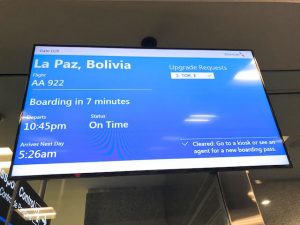
I was at gate 20 in time for my flight from Miami to La Paz, Bolivia this evening. I was lucky enough to get an aisle seat in the exit row. The middle seat was open. The plus was that I had extra leg room. The drawback to the exit row is that the arm rests are fixed. The width of the seat is pretty much 100% filled up with me. I know there are people bigger than me. There is no way they could fit in these exit row seats.
I had the pleasure of meeting “Juan Carlos” who was sitting in the window seat. He and I spent several minutes talking. He was a native Bolivian. Juan Carlos has lived in the U.S.A. since 2000. He was returning to his hometown of Santa Cruz for just four days to participate in a bicycle race. From what he was telling me the bike race would take place very near the car race in Santa Cruz that I was coming to Bolivia to see. Juan Carlos had a lot of good advice for me. Great meeting J.C.
Friday – April 27, 2018
I had made it to Santa Cruz, Bolivia. On the one hand a hard part of the trip was over. I left home 35 hours ago. I had spent TWO nights flying on airplanes. The flight time of 13 hours was not all that bad. However, when thirteen flying hours are added to 22 “layover” hours with no hotels that’s requires much of my travel patience.
Now I was entering probably the easiest part of the entire trip. I would be staying for four nights at the Marriott in Santa Cruz. That’s good duty.

My main Santa Cruz contact, Manalo Chavez picked me up at the airport. It’s always great to have a local person on your side when visiting a country where English is not the primary country.
I have visited many countries over the years where English was not the main language and often not even the country’s second language. In most of those situations I’ve had someone “on the ground” to help shepherd me along. I hope that each and every one of my “shepherds” is reading this and knows how very much I have appreciated their help. If I ever win the Powerball lottery each of those folks is going to be very happy.
Manalo Chavez doesn’t speak all that much English. I speak even less Spanish! Nevertheless, we communicated very well. He and I often used the audio version of Google Translate to “talk”. We would smile with understanding when our phones told us what the other was intending to say.

Our first stop from the airport would be at the Marriott hotel in Santa Cruz. I would be staying at this hotel for four nights. I’m not sure I recommend staying in a place like the Marriott when I’m in a place like Bolivia.
I learned from my English based India mentor Allison Smith that staying in upscale local hotels is better in many ways than staying in upscale American hotels in foreign countries. However, the Marriott program was just too much to pass up.
The Marriott property was brand new. It opened on December 29, 2017. The room price at the Marriott was more than reasonable and about the same as what I would have paid for a lesser quality Bolivian brand hotel. Don’t worry. I will have six nights of very Bolivian hotel experiences after I leave the Marriott. I’m looking forward to that.
The Marriott experience included so many extras baked into the price. First of all, the Marriott property was opulent. I once heard a trackchasing fellow competitor say that he chose to bypass a certain hotel for his wife and him because it was too opulent. Say what?
When I travel with my wife I WANT opulent. This is the same trackchaser who just can’t really tell folks why he does the things he does. In this example why doesn’t he just say, “I’m cheap and I don’t even care if my wife is coming along, I’m still cheap.” Honesty is always the best policy.
I get a lot of extra perks with Marriott and Sheraton because of my platinum elite status. I stayed at these kinds of properties SO much during my working career they gave me LIFETIME platinum elite status. Yes, you can imagine how much I used their properties. I have been retired for 16 years. It’s nice having lifetime status.

When I checked in they gave me a complimentary cool drink. Then they upgraded me to a two-room suite on the sixteenth floor of the 19-story hotel tower. I can see almost forever toward the city centre of Santa Cruz from a window that is almost twenty feet wide. I also have 24-hour use of the Executive Lounge. There I get free breakfast in the morning and free dinner in the evening. I can go up to the lounge any time of the day for snacks, and free bottled water and soft drinks. They also throw in free high-speed Wi-Fi that would cost other guests an extra $10 per day. No, the Marriott program is simply too good to pass up. On top of all of the above I would be earning points toward free stays in the future.
With an early check-in I would relax and nap for a good four hours. A shower in my deluxe bathroom REALLY felt good after sleeping on airplanes for the past two nights. At 2 p.m. Manalo dropped by. We were going to explore Santa Cruz in a most unique way.
Manalo and I have been sharing messages for a year. When he gave me his group’s 2018 race schedule I saw that the late April event, their first race of the season, would fit my schedule perfectly. I signed on. Manalo was happy about that.
He tells me that most things in Bolivia cost more than they do in the United States. Manalo had asked about the prices of iPhones and drone batteries in the U.S.! The IPhone, even in the U.S. was expensive by Bolivian standards. I was able to pick up a couple of drone batteries at a Fry’s Electronics store in Austin, Texas for Manalo. I think I saved him a good deal of money. He paid me for the batteries in Bolivian Bolivianos. That way I won’t have to exchange many for the rest of the trip.
Manalo is a racecar driver. He races in the “car cross” division. Manalo calls the cars “buggies”. From the airport we began visiting auto parts stores. He needed a few replacement parts for tomorrow’s “classification” meeting at the track. From what I can tell “classification” is a combination tech inspection and time trial. I guess I’ll know more about that after I get to the track on Saturday.
I can tell you that I’ve never gone on a parts store run with a racecar driver in a foreign country before. That’s what my hobby is all about…. seeing and doing things I’ve never done before in places I’ve never visited before.
For my last several foreign country trackchasing trips I’ve made a habit of visiting the racing garages of the driver’s helping me see their country. It’s really a lot of fun to get the “behind the scenes” tour of these race facilities.

Manalo and his wife Anna Maria and their four boys live below the race shop. I had a brief chance to meet Anna Marie (right) and her friend, Lilliana (left). The two ladies began their friendship at “University”.
Today Lilliana aka Lily hopped in the car and helped translate for Manalo and me. We drove all over Santa Cruz, stopping at the bank and a couple of more parts stores.
During the drive I saw what looked like a circus tent. It was. I love the circus and have seen a few international circus performances most recently in Belarus but including Russia and China as well. Soon we were making arrangements for both Manalo’s and Lily’s family (that’s six kids! plus the adults) to go to the circus tomorrow night as my quests.
It was getting to be late afternoon. We all started talking about food. I’m explained the American definition of “hole in the wall” when it comes to eateries. Neither Lilly or Manalo had ever heard the phrase.
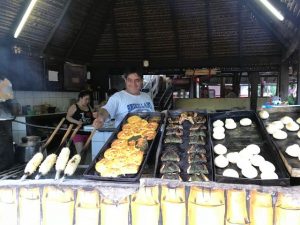
Soon we were pulling up in front of an authentic “Bolivian Cabana” restaurant. These are small family-owned open-air restaurants that serve food cooked on grills. We went to an area where about twenty of these places were right next to each other.
Lily and Manalo ordered for our table. Soon we were dining on Yucca, fried bananas and a corn based arepa along with a delicious tasting sweet empanada. Please. Don’t miss the photos!
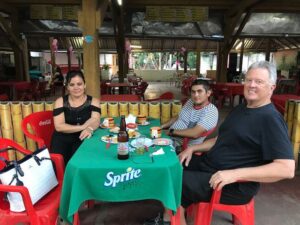
We enjoyed our food and even more so our conversation. I explained the concept of “ambience” when it comes to my enjoying these international experiences. I told them it’s all about the “feeling” of the experience. That feeling comes from the people and the food and the sights and sounds. I think they understood.
It was dark when they dropped me back at the Marriott. We had big plans for tomorrow. Much of the day Manalo and I would spend at the track. In the evening the families would get together for a night at the circus.
Folks, I must tell you that when I first started “trackchasing” I had ZERO idea it would morph into a worldwide travel opportunity. That proves a point I believe in 100%. It’s impossible to predict the future.
This was day three of my 13-day adventure. It almost felt as if it were day #1 since I had just met my new friends and began to get to know Bolivia to some small degree. This is going to be a wonderful trip.
I do have one item that is bothering me just a bit in the back of my travel mind. Later in this Bolivian adventure I’m going to be traveling at some very high elevations. For the last six nights of the trip I will be sleeping at 12,000 feet. Next Sunday’s racing activity takes place at 14,000 feet. It’s going to be a challenge. It’s somewhat concerning to me but I’ll enjoy the first half of the trip before I fret too much about not being able to get enough oxygen.
Saturday – April 28, 2018
The day began with Manolo coming over to the Marriott hotel. We had a nice relaxing breakfast at the 19thfloor Executive Lounge. Manolo had a busy day planned for us.
When breakfast was finished we were off across the city of Santa Cruz de la Sierra. I find Santa Cruz to be most similar to Mexico in city scenery up to now. The city streets are rough and the driving is aggressive. If there is an open space in traffic it is quickly filled with the willing opportunist. There is no shortage of Bolivian opportunists.
I also saw more drivers pushing their broken down cars or try to repair them than ever before. I must have seen ten or more disabled vehicles on some days.
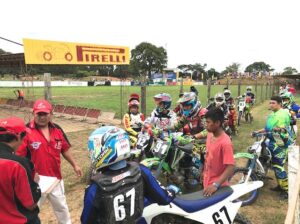
Manolo had a surprise for me. He asked me if I liked “moto”. He was referring to motorcycle racing. Of course I do. This morning a special motorcycle race was taking place in Santa Cruz at the Motodromo quito Cardona track.
Events like this would be somewhat difficult to find and navigate on my own. Yes, if I had to do it I could. Today I just needed to sit in the passenger’s seat and enjoy the day.
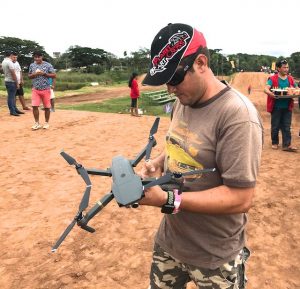
Manolo brought along his drone to record some of the racing from the air. I would love to have one of those for my own video recording. However, with the restrictions the U.S. has and will have on drones I probably won’t get one. I had purchased a couple of drone batteries in Texas last week for Manolo’s drone.
We watched several races. Manolo made special arrangements with the track management for me to get a very up close and personal view of the start of one of the races. With more than twenty-five riders it was wild! The bathrooms at the track (banos) were managed by young woman who passed out toilet paper for a small fee.
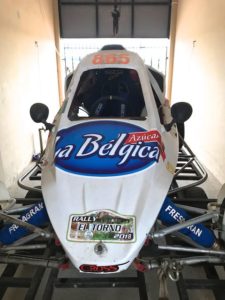
After the motorcycle races we returned to Manolo’s race shop and home. It was time to get his car cross racecar loaded on the trailer and ready for today’s “classification” which is the Bolivian term for qualification or time trials. Don’t miss the pictures of the race shop and the unique way they put the car on the trailer.
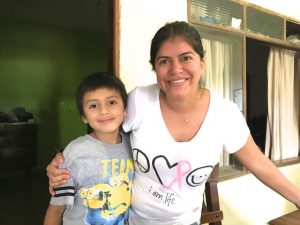
Before we left the shop Manolo’s wife, Anna Maria aka “Anita” had made lunch for us. She had a lovely meal served in their kitchen of beef steak and a dish of rice, milk and cheese called con quesa. Delicious.
I believe that you can’t really call someone a friend unless you have shared a meal or played a round of golf with them. Now Anita had joined Manolo as my friends! Of course their boys Jimmy, Sebastian, Eduardo and Diego were now my new Bolivian friends as well.
I first met Sebastian age 10, when he was sweeping out the race shop as the car was being prepped for today’s racing. He went about his business quietly mindful that a stranger was in the shop. Sebastian warmed up to me quickly when I offered to help him sweep! He spoke and understood English well. He even showed me his tee ball bat and baseball!
It was a good 20-minute drive from Manolo’s shop to the Autodromo Santa Cruz. It was all city driving. I kidded Manolo that it was like playing a video game. Pedestrians and cars were darting in and out at a dizzying pace. There was very little motorcycle traffic and virtually no dogs. I guess that made this video game easier to play!
When we got to the track Manolo got to the business of getting ready for classification with his crew. Since they all spoke exclusively Spanish and I don’t know a shock absorber from a steering wheel I went about exploring the Autodromo Santa Cruz from stem to stern.
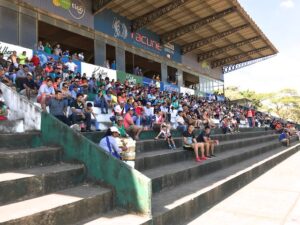
The facility has a large covered grandstand with poured concrete spectator seating. From some of the old signage it looked as if this place used to hold horse racing events. One of the track workers told me, via Google translate, that they have been racing cars here for about twenty years. By the way I used Google translate quite a bit during this trip.
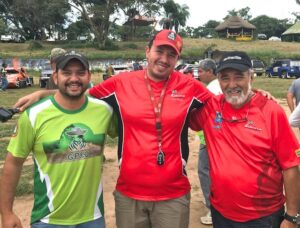
Manolo introduced me to the folks running the races today. They didn’t speak any English at all but seemed pleased to have the World’s #1 Trackchaser in the house.
They invited me to ride in the pace truck for a couple of laps. Don’t miss the video on that! I got to ride shot gun for a fantastic view of the track.
The track surface is dirt. To be more precise it is sand. Some of the turns of this road course are slightly banked. There are no guard rails of any kind. In essence it seems as if the track has been carved out of a huge pasture/jungle.
Today I also had plenty of time to take pictures of the racecars. Manolo told me there were six racing classes. I’m going to guess there were about 40 cars plus or minus in the pit area today.
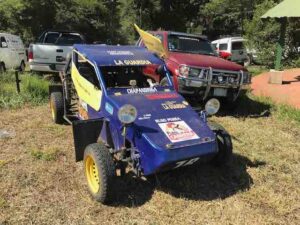
I will say this. Many of the race cars did not look like any cars I’ve ever seen in the U.S. or any other place for that matter. That’s uniqueness is what make international trackchasing so much fun.
When qualifications were finished we loaded up and went back to the race shop. I’ve added touring race shops to my international trackchasing agenda for the last several international visits. I’ve gotten personal tours of shops in these countries over the past year or so. Prior to that I really hadn’t done much of that at all.
Zimbabwe
Namibia
Macedonia
Ukraine
Maldives
Bolivia
It had been a long day at the track. However, in a way our day was just beginning. I took a taxi back to the hotel from Manolo’s. The more than 20-minute ride was just 20 bolivianos or a bit more than three bucks.

Earlier during my rides through Santa Cruz I had noticed a circus (circo) tent. I asked Manolo about the circus and when they had shows. They had one tonight! I offered to treat everyone to a night at the circus. Who can turn down an offer like that!
We would be going to the 9 p.m. performance. That seemed a little late for the kids but Manolo assured me they were up for it.
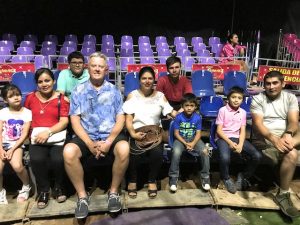
We would have a group of nine. In addition to Manolo and his lovely wife Anita, sons Jimmy (14), Sebastian (10) and Eduardo (5) joined us. Diego stayed home with grandma. Also joining in on the fun were Lily, Anita’s best friend from school, and her two children Gabriel (14) and Brenda (8). We were a good-looking group.
Tonight the circus had two shows at 7 p.m. and 9 p.m. The circus tent was on the smaller side. We had front row seats. Again, you’re not going to want to miss the video from the circus. For a smaller show they had some very talented people.
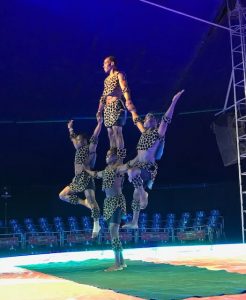
At intermission the smaller kids got souvenirs and their picture taken with a full-sized transformer/automobile. Everyone had a really fun time. I enjoy simply watching the faces of the kids at shows like this. I can go to Disneyland a million times and it’s always being able to see the kids having fun that is the best for me.
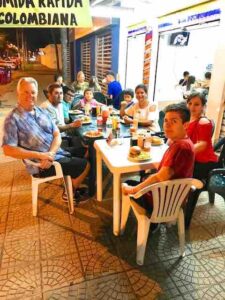
We got out of the circus at about 11 p.m. Lily had recommended we stop at a place that served Colombian hamburgers. Everyone was up for that so off we went. This was a little “hole in the wall” place that provided a perfect nightcap. The weather was lovely and the company even better.
When it was time to depart Manolo tracked down a local taxi for me to get back to the hotel. The rest of the gang hopped in the Subaru and headed back home. A good time was had by all!
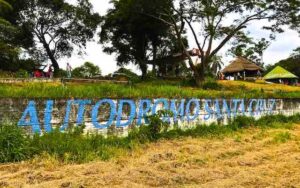
Sunday – April 29, 2018
Today is race day! It doesn’t get any more special than saying that on one of these international trackchasing trips. I was headed to the Autodromo Santa Cruz racetrack.
Our night ended late last evening. We got back from the circus and dinner at about midnight. I probably didn’t get to bed until after 1 a.m. This morning’s alarm was set for 7:30 a.m. It seemed to come quickly.

Manolo was coming to join me for breakfast. It was a most pleasant surprise when his oldest sons, Jimmy and Sebastian joined us for the morning meal. We all headed up to the 19thfloor Executive Lounge. There the boys were treated royally by the young Spanish-speaking woman managing the lounge. I asked her to make sure the boys knew they could have anything they wanted. That seemed to go over well with them!
Next up we were headed to the track. Manolo told me we needed to arrive by 9 a.m. Driving in Bolivia is not for the faint-hearted. Yet, the cars seem to have a “force field” around them. Many of the roads are 2-3 lanes wide. Generally, there are no road markings. The local drivers take that to mean they can put their car anywhere they want it…and they do! Manolo sometimes practices his race driving skills on the drive around town if you know what I mean.
Manolo and his crew left the racecar and tow rig just outside the track after yesterday’s “classification” action. He told me he pays someone to watch the cars in what is essentially an open area. It’s a lot easier than towing all the way across town after Saturday’s racing and then back again on Sunday morning.
I don’t know exactly what they were charging as admission for today’s racing. Manolo had passes for the four of us riding in his Subaru passenger car.
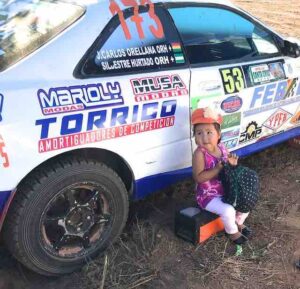
Today Manolo would be busy tending to his racecar. I was off to tour the pits and get as many photos of the competitors as I could. Today was much sunnier (and better for photo taking) and hotter (not so great for watching the racing) than yesterday. Walking around the grounds is somewhat difficult. It’s much like a farm pasture with uneven ground and lots of roots.
Oftentimes it is difficult to know exactly what is going on at one of these foreign-based races events. They did have an announcer today. However, as you would expect he spoke in Spanish only. There was no race program. Other than a visual observation it was difficult to know exactly what was going on. If you imagine watching a sitcom or dramatic TV program without any sound then you might know how it was today.

I attended the driver’s meeting as I did yesterday. Again, I had absolutely no idea what was being discussed. However, once you’ve been to a thousand driver’s meetings then you can pretty much imagine what the next one will be like.
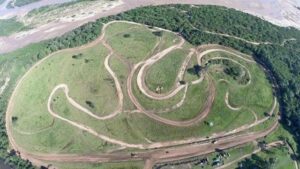
Today’s racing would be done on a dirt road course. There was virtually no elevation change. There was also a good deal of vegetation in the form of grasses and vines growing just high enough to prevent seeing the racing all that well. To top it off the sand base of the track itself was sunken just a bit. No, it wasn’t all that easy to see the racing.
They did take one class out onto the track following the pace truck. I figured they would take a lap or two, which they did, and then start the first race. They did take a couple of laps but they didn’t start a race. The cars simply pulled back into the pits! I’m thinking they might have been out on the track to run in the water that had been laid down. I don’t know for sure.
The next activity was to have six or so racers lineup in what served as the pit area yesterday. Today the pits were moved over about 100 yards from where they were yesterday. I figured I had time to get up toward the grandstand seating area before those six cars left the pits and moved onto the racetrack. Wrong! While I was walking behind the grandstand, and out of sight, from the pit area the cars started racing! Dang. I would come to learn that the race start was just off the main track in what had been the pit area yesterday. Yep. I missed the start of the very first race!
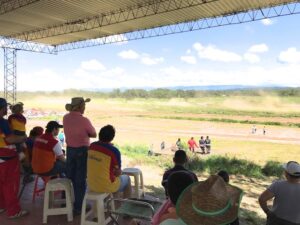
No problem. There would be plenty more for me to see. There was something odd though. The cars and by “cars” I am referring to all of the competitors at the track today, including trucks, buggies and car cross entries were not racing on the configuration they did their “classification”, i.e. qualifying on yesterday. Interesting!
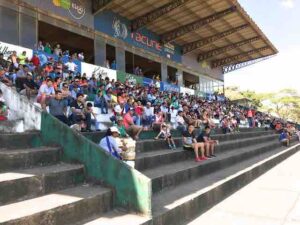
It was warm, probably about 90 degrees Fahrenheit. A large crowd sat in the covered poured concrete grandstand. From what I could tell in nosing around the entire “Autodrome” horse racing once dominated here.
Everyone I’ve met in Bolivia and at the track have\\s been super friendly. Today I was wearing my “World’s #1 Trackchaser” shirt. Several people came up to say “Hola” even though they didn’t speak English and, of course, I don’t speak Spanish.
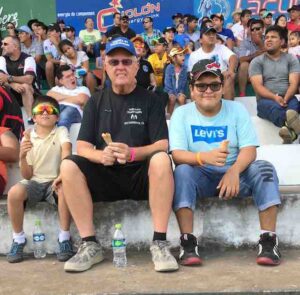
Some of the time I sat in the grandstands with Jimmy (14) and Sebastian (10), both sons of Manolo. I bought the ice cream cones for us and they handled the financial transaction managing my Bolivian bolivianos!

There was plenty of time to walk around just people watching. For the second consecutive day I met and surpassed my goal of walking more than four miles. I need every day I can get after falling behind my trackchasing/power walking goal at the end of the first quarter.
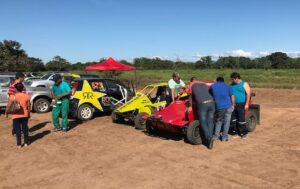
In talking with Manolo, he told me there were six racing classes today. He also mentioned that each class ran just one race. Manolo and I can’t always manage our Spanish/English language differences. I could swear I saw more than six races. Maybe some classes were having more than one race?
The first couple of classes ran on a track quite a bit smaller than what they had qualified on yesterday. I had a sense that as least some classes would race on the bigger track. They did!
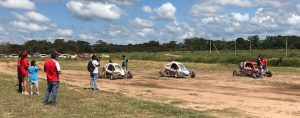
There were four general types of racers today. Manolo’s class is called “car cross” (above). This is a class sometimes called “kart cross” in parts of Europe. There were also dune buggies, cars and trucks. It was one or more of the car classes that ran on the bigger “outside” dirt road course.
What did all of this mean? I had seen racing on TWO different tracks at the Autodrome Santa Cruz. I came to Bolivia expecting to see racing at two different tracks. However, I did not expect the two tracks to be in Santa Cruz only.
Afterwards, Manolo told me the folks actually race on THREE tracks here. However, trackchasing rules only allow me to count two of those three tracks. Here is how the rule on this topic reads,

“all tracks falling under the road course category are only separately countable if at least one of the following conditions is met:
– they share no common racing surface
– they meet the change of surface rule
– they consist of one permanent and one temporary road course, which share a minority of common surface
– they consist of two variants, which share a common surface, but which are distinguishable by at least one straight and three separate corners
– they have separate track combinations which can be used separately or form the track together. In this case only 2 separate variants (either 2 parts or 1 part and the entire track, consisting of a combination of the variants) can be counted.”
I know what you’re thinking. Who wrote these rules the IRS? The trackchasing rules needed to be “tightened up” just a bit when I started trackchasing. You see I know how to operate in the grey but in the legal grey area. This has aggravated the most competitive trackchasers to no end. In several instances they came up with “Randy Rules” to combat these grey areas. At the time I pitied poor Will White, Trackchasing Commissioner at the time. The trackchasing power brokers gave him the responsibility to stop my aggressive but 100% legal techniques. That’s why the rules are written as if a retired IRS audit compliance officer wrote them.
Today Manolo got second in the three-car car cross feature race. He told me that several car cross racers were off competing in Argentina! At the standing start the fast qualifier got an early jump. He created such a dust storm that Manolo had to nearly stop until the dust cleared. By that time the race was effectively over. The car cross winner did quite a “burn out” in the sand following the race.
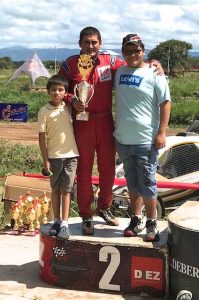
Today the top three finishers in each class made it to the podium to receive their trophies. It was fun seeing Sebastian and Jimmy standing with their dad on the podium. Neither one of the boys let go of that trophy for the rest of the day!
The actual racing had started at about 10 a.m. We were loaded up and leaving the track about three hours later. It had been a hot dusty day. I’m not sure how many more races were still going to be run after our 1 p.m. departure. I think I saw about ten races. When we left probably half the cars were ready to be taken back to their racing garages.
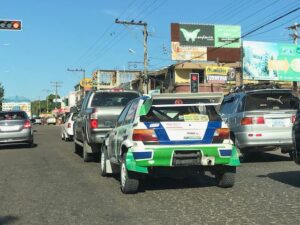
I did see some very unusual, in today’s racing world, sights. First, several of the racers were “flat towed”. That means the racecar rolls along on the ground behind the tow car. I have not seen that in years! They used to do it that way back at the Peoria Speedway (lifetime track #1) in the 50s. There were ZERO enclosed race car trailers seen at Autodromo Santa Cruz this weekend.
I did happen across a couple of teen-age boys who might have been smoking something “kind of funny” under the grandstand. Today I also encountered a couple in a truck where “incense” seems to be coming from their general area. I’m just sayin’. Other than that, I have only seen one person in three days smoking anything and that guy was a racer from Spain!
Although my research shows that Bolivia has one of the higher smoking rates (17%) in Latin America I just didn’t see anybody smoking. Cuba’s smoking rate in 36.6% and Panama’s only 3.5%.

After the races we headed back to Manolo’s house. There his wife Anna Maria and her close friend Lily had been cooking up a storm. They had been out early buying groceries. Then “Anita” and Lilly had prepared the Bolivian national dish, chicken picante, just for me. First, I was honored. Secondly, I was most appreciative. What a nice thing for them to do. Gracias ladies!
After a dessert of peaches, we sat around the dinner table talking. Lily acted as our translator when needed. Folks, I’ll repeat what I say to you from time to time. I had no idea trackchasing was going to take me to so many unique places and meet so many friendly people when I first started. I just didn’t know what I didn’t know.
When it was time to leave, Manalo called a taxi to come pick me up. I can ride across virtually the entire city (15-20 minutes) for twenty bolivianos or about $3 USD. Taxis are one of the best buys in Bolivia so far.
When I got back to the Marriott I took a nap! We were out late last night with the circus. Then with today’s heat and dust I was bushed.
However, when I woke up at about 5 p.m. I was refreshed. I had meant to bring two pairs of board shorts with me on this trip. Mistakenly, I left one pair at home. I dropped the only pair I had in Bolivia in a sack and sent it to the laundry at the hotel. In a couple of days my touring will change to a much colder climate. No board shorts then.
I had seen a huge modern shopping center while taking my rides back and forth to the hotel. The Ventura Mall was just three blocks from where I was staying. After dark I took a walk down there. This assured me of surpassing my four-mile per day goal.
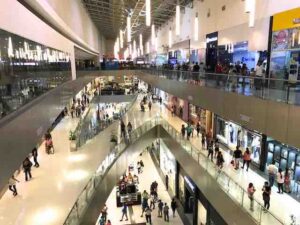
The stores don’t close at the mall until 10 p.m. When I arrived the shopping center was jampacked. I read somewhere that foreign countries with very warm climates have their residents visiting air-conditioned malls because they don’t have air-conditioning at home. I think there is something to that.
While at the mall I decided to see a movie. I love going to the movies. I’ve seen movies in more than ten foreign countries. Have you ever been to the movies in a foreign country? I saw “Paul, Apostle of Christ”. It was shown in English with Spanish subtitles. The theatre was super modern and would rival anything I’ve seen in the U.S. Tickets prices were higher than expected. I paid 95 bolivianos or about $13.80 USD.
After stopping in the mall’s food court to get some self-serve frozen yogurt, I took the leisurely walk back to the Marriott. When I left the mall at 9:30 p.m. it was still wall to wall people and this was a Sunday night.
I had come to Bolivia to see auto racing. I had no idea I would meet so many nice people. This has happened in so many countries. People just like being nice to strangers I guess. I’m lucky. I’m real lucky.
Monday – April 30, 2018
Today was the day AFTER the race. That’s always a little anti-climactic. The race brings me to these countries. However, as you have seen and will continue to see it is the people and the sights that will bring long lasting memories.
Today my first “agenda item” wasn’t until 1 p.m. That being the case I just slept in. That felt good, really good. I’ve got a lot of stuff to do in Bolivia before I begin to head home in a week.

At one o’clock I was going to meet Liliana. Of course, Liliana is Manolo’s wife’s (Anna Maria) best friend and has been part of the entertainment committee from the first day I arrived into Bolivia.
Liliana speaks both Spanish and English. She’s the only one of the four of us that does. She and I would tour the nearby “traditional” Bolivian town of Cotoca. The town has grown from 2,000 people in 1976 to more than 24,000 today.
Nevertheless, it’s still a small town. Nearby Santa Cruz, where I’ve been staying has 1.4 million residents.
Lily and I would take a “trophy” car from Santa Cruz to Cotoca. The distance between the two cities is only 37 kilometers or about 20 miles. A taxi would cost us 25 bolivianos. If we took a taxi it would just be the two us in the car.
When I travel I’m up for doing and seeing “new” stuff. I’ve ridden in a million taxis. Once in New Orleans my driver was pulled over for a speeding ticket. Another time in downtown Minneapolis my driver stopped to make a delivery in a high-rise building. Following the delivery he was taking me to the airport. While he went off to make his delivery he told me to drive his cab around the block on a late Thursday afternoon in downtown Minneapolis. Here I was dressed in a business suit driving a cab in heavy city traffic. Yes, I’ve been there and done that with taxis.
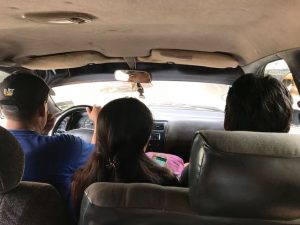
Today we would take a “trophy” car. This type of ride is like a taxi but it does not leave for its destination until all five of the passenger seats are taken….by whomever. The fare would be just five bolivianos per person.
I didn’t select a trophy car to save 15 bolivianos. I asked Liliana to get us into a trophy car as an adventure. Many of the taxi type cars I’ve ridden in have been pretty well worn out. The taxis at the Marriott are late model cars. However, the taxis my friends have put me in have been several clicks south of “beaters”. Each time I’ve gotten into one of these cars the driver has already been instructed in Spanish where I need to go. On my own I would not have ridden in most of these cabs!
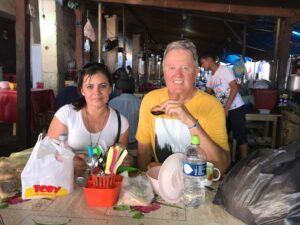
Lily and I had a great time touring the authentic small Bolivian town of Cotoca. We tried a little local food. We saw the sights. We experienced the local culture. Lily, thanks for taking some time out of your day….and riding all those buses to meet up with me!
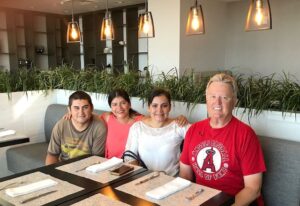
Tuesday – May 1, 2018
This morning would be a “get away” day from Santa Cruz. It would be my last chance to say my good-byes. Manalo, Anna Maria and Liliana all came over to the Marriott to join me for breakfast.


The ladies had not yet visited my hotel. This gave me the chance to give them the grand tour. After breakfast in the Executive Lounge I took them to the pool area with its private cabanas. Then we made a stop so I could show them my hotel suite. They loved it all. In Santa Cruz staying at the Marriott was a little bit more expensive but by U.S. standards not too bad. The Marriott always treats me right.
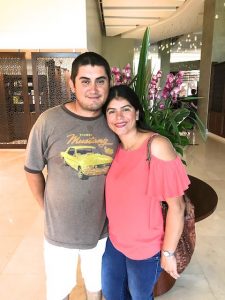
I certainly had a lot of thanks for Manolo Chavez and his family. Manolo went out of his way to make sure my trip to Santa Cruz was a success. Gracias, Manolo. Maybe we will see each other again, but maybe in a different country!!
Today I was supposed to be flying to Sucre, Bolivia. Sucre sits at an elevation of about 9,000 feet. For the past five days I had been in Santa Cruz with an elevation of about 1,500 feet. Sucre was supposed to be somewhat of a midway “acclimation” stop on the way to 12,000 feet and more where I will spend the next week.
However, Lucia my travel agent messaged me to say that Sucre was holding a city-wide strike today. May 1 in Bolivia is “Worker’s Day”. I didn’t know if the strike had anything to do with that or not. Nevertheless, the strike would make everything stop in Sucre. That meant I would now be flying directly to Uyuni. The elevation at Uyuni is a bit more than 12,000 feet.
This meant there would be NO altitude acclimation. I was going from about 1,500 feet to more than 12,000 feet in a one-hour plane ride. My ability to handle these high altitudes and avoid altitude sickness was a major concern for me. Now we were going to see if that would really be a problem.
After my guests left the hotel I had a few hours to kill before my driver arrived to take me to the Santa Cruz airport. The Venture Mall was only a 10-minute walk away. There was just enough time to catch my second movie of the trip.

I bought a ticket to see the Avengers. I am NOT a Sci-Fi movie fan. I’ll go a few years between seeing Sci-Fi movies. Then I will try one just to make sure I still don’t like them. After seeing the Avengers….I still don’t like them but at least I gave the genre another chance.
In the late afternoon my driver showed up to take me to the airport. He was a friendly sort. The driver explained to me how a “citywide strike” simply stops the city in its tracks like the one happening today in Sucre.
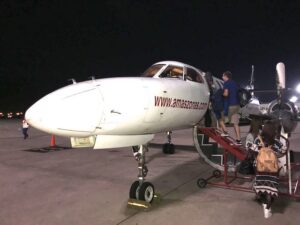
The plane taking me from Santa Cruz up to Uyuni, situated in the Andes Mountains, was small. There was just one seat on each side of the aisle. The plane could carry about 20 passengers and was propeller driven. Tonight the plane was about have full.
I boarded the plane and then went into full panic! I wasn’t panicking about the small plane that we would be flying into the mountains at night. Most folks would certainly panic about that.
I panicked because I had lost my reading glasses all of a sudden. I had them in the airline terminal just before we boarded the plane. From the terminal we boarded a shuttle bus that took us to within 20 feet of the plane. Now I was in the plane and I didn’t have my glasses! With the language barrier and the need for the plane to get going I couldn’t make a full search. In the end…no reading glasses! I did have my “computer” glasses. They are good for reading things about 30 inches away. I also had my store bought non-prescription sunglasses with readers. For the rest of the trip I would have to “make do”.
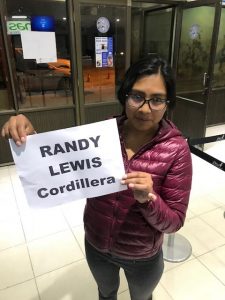
The flight to Uyuni took about 1.5 hours. Landing in Uyuni was very similar to landing in Barrow, Alaska like I did this winter. The airport, and later the town, was small, rustic and way off the beaten path. At every cross street dogs were eating the garbage piled into the streets. It seemed as if they were expecting me.
In order to avoid altitude sickness my doctor prescribed Diamox. For it to work I began taking it a day before I hit the high altitudes.
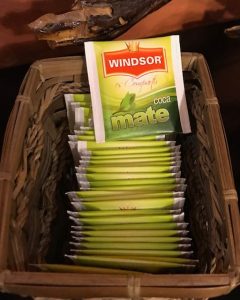
Drinking tea….coca tea is also recommended to avoid altitude sickness. By the way, I absolutely hate tea! I probably have never drunk a complete cup of tea in my life. Nevertheless, I started drinking coca tea a couple of days ago. I still hate tea!

My travel agent had set me up with a very quaint looking little hotel, especially for a town that had mostly dirt roads in the downtown area itself. I would be staying at the Hotel Jardines de Uyuni. The place was painted with bright colors like you might find at a New Mexico upscale resort.
This was my first night of sleeping at more than 12,000 feet. I did not have the normal symptoms of high altitude sickness, which are headaches and nausea. However, I did have a hard time getting my breath. Being at altitude, and taking Diamox makes you pee a lot too. I was up every hour peeing and straining to breathe. I was concerned but made it through the night. Thankfully, each sleeping night got better. By the end of the trip I barely knew I was operating at 12,000-14,000 feet.
Wednesday – May 2, 2018
I woke in Uyuni, Bolivia this morning. It had been a fitful night of sleep. At 12,000 feet above sea level it was hard to get enough oxygen. All of my advance research told me I had to keep drinking water and stay away from caffeine. I’m a big Diet Coke drinker. This was going to be difficult to swallow, pun intended. Additionally I had picked up a case of diarrhea, likely from eating street food yesterday before I reached the high altitudes.
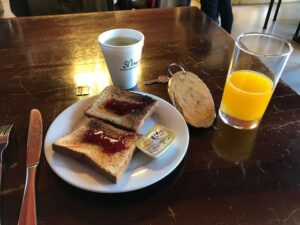
Breakfast was included in my tour package. Again previous travelers told me to eat light. What I did eat should be mostly carbohydrates. With that in mind I had just two pieces of toast with jelly and 4 ounces of orange juice….and plenty of water.
Last night I paid four dollars at the airport for two coca tea bags. Today at the hotel I could have all of the coca tea bags I wanted for free! Oh well, live and learn.
I am not a tea drinker. I had never been a tea drinker. I’m not sure until this trip if I have ever drunk a full cup of tea in my life. However, everything I read about altitude sickness says it is a real bitch. I am doing everything I can to avoid it. So far, I’ve had three cups of coca tea. To me tea tastes like dunking my dirty socks in a hot cup of water and drinking it!

My bus from Uyuni to Potosi was not leaving until 1:30 p.m. The ride would be nearly four hours long. I was actually looking forward to that. No better way to see the country than with someone else doing the driving.
I wanted to take a walking tour around Uyuni this morning. Starting with last night I’ll be at 12,000 feet above sea level for the next six nights. I’m hoping being at that altitude becomes somewhat “normal” in a day or two.
I usually bring too many clothes for these trips. I want to have clean clothes for each day of the trip. I want to be prepared for all expected weather eventualities. My first five days in Santa Cruz had high temperatures of 90 degrees. The last eight days would have high temps of sixty with lows near freezing.

This morning, when I started my walk around Uyuni the temperature was in the 50s with lots of sun. I could have easily worn shorts but I was stuck in blue jeans. I hate long pants almost as much as I hate tea.
At this elevation just walking was a chore. I took it slowly. I almost felt as if I wasn’t totally in control of things. Maybe that’s why people who have had too much to drink sometimes drive very slowly.
Uyuni, a town of about 10,000 people, is “rustic” if nothing else. The main streets are covered in paving stones. The side streets are dirt. It looks as if the main share of the population is made up of “indigenous” people. Uyuni is the starting point for about 60,000 people each year on their way to the Salar de Uyuni salt flats. That’s why I was here.
There wasn’t a lot to see. I wasn’t really in the market for anything. I did buy some postcards for the family back home. Buying post cards is never difficult. Finding stamps to mail the cards back to the states is the challenge.
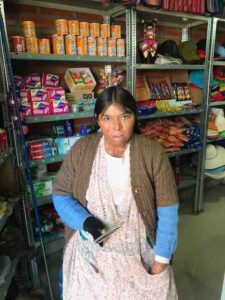

The lady who sold me the cards (above) told me, in very broken English, I could get stamps at the post office a couple of blocks away. About thirty minutes later I found the post office. That was only after asking several people on the streets where it might be. Then I found the post office closed! No good deed goes unpunished.
So far, my “transfer” drop offs and pick-ups, arranged by the Kimkim travel group have been flawless. This is all part of the total package I purchased.
As my request they dropped me off at a Bolivian pasta restaurant. When I tell you about pasta restaurants and post offices and post card shops don’t think of them as like most you have visited. Very little or no English is spoken or understood. Hand gestures are important.
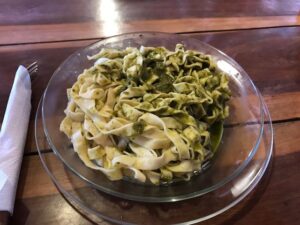
I was looking to have some carbs for lunch. I did. I finished having a lunch of linguini pasta noodles in a pesto sauce with garlic bread (cost $45 bolivianos or a bit less than $7 USD). My driver was at the agreed upon spot to pick me up and take me to the “bus station”. Again, the Uyuni bus station is probably not much like what you might image.
The bus had a capacity of about 32 passengers. There were only 6-8 folks on the bus. There was no bathroom on the bus. That’s not good for a fellow drinking a gallon or more of water with diarrhea is it? It would just have to be mind over matter.
By the way, since Bolivia doesn’t accept credit cards in their small ma and pa establishments I must pay with cash, Bolivian bolivianos. I often times get coins back in change.
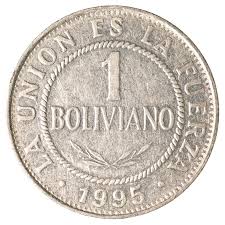
I hate coins more than I hate long pants and almost as much as I hate tea. In the U.S. more than 99% of the time I will never have a coin on me. I pay for virtually everything with a credit card. If I’m with Carol and I ever get coins as change I immediately give here the coins.
I have not carried a wallet in well over thirty years. I have not mown grass since 1983. I don’t carry keys. When I do have a single key on me it is the key to the Carol Lewis owned and MFunds sponsored Lexus RX350. Then the key is in my computer bag and not on my person. When I don’t like something I stop my involvement with the activity and never do it again. This all makes for a happy life.
In foreign countries I sometimes MUST have their coins on my person. I carry my money clip with a couple of credit cards and a check or two in my right front pants pocket. When I have coins in the same pocket they get caught up in the bills. When I pull out my money clip the coins go flying all over. This immediately reminds me how much I hate coins.
In Bolivia I’ve gone to carrying my money clip in my right rear pocket. The Bolivia coins are in my right front pocket. With my money clip in the right rear pocket it hurts my butt and feels like a hip pointer. That’s why I gave up carrying a wallet so many years ago.
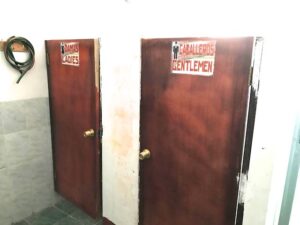
When I arrived at the Potosi bus station I had to take care of two things one of them quickly. First, I had to hit the bathroom. Folks with an ongoing case of diarrhea shouldn’t be on buses with no bathroom for four hours. Most people with diarrhea know that. Most people with diarrhea don’t live my travel lifestyle.

Of course, the “banos” was up two steep flights of stairs. I had to pay one boliviano to use the bathroom. My purchase came with a couple of sheets of toilet paper. I had my own in my back pocket!
I rushed up those two flights of stairs with more than 50 pounds of luggage. When I got to the top of the stairs I was huffing and puffing to beat the band. That was a problem but it was time to address my other problem!
Most commercial toilets do not have a toilet seat OR a toilet cover in Bolivia. Don’t worry. You get used to it. The stall was not big enough for me and my luggage. There was no way I would be shutting the door and leaving my luggage outside at this bus station. That meant the door didn’t get shut. No big deal. I didn’t know any of these people.
With THAT taken care of, I needed to find my driver to take me to my hotel. However, I couldn’t FIND my driver. I used “WhatsApp” to contact Lucia my travel agent. She was on the case quickly and recommended I take a taxi. Her driver’s car had broken down.
Most travel books will tell you not to hail an unmarked taxi in a South American city. What choice did I have? I got a good guy. He had a Christmas tree shaped air freshener in the colors of the U.S. flag. Although it seemed as if we drove a long time to get to the hotel the fare was only 10 bolivianos or about a buck and half.
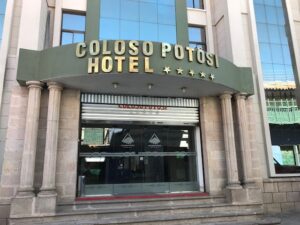
I would be staying at the Coloso Potosi Hotel in the center of Potosi. This was more of a city hotel. I’m glad I paid a little more to get my hotel package upgraded from the basic hotel group. Nevertheless, it would have been interesting to see what the basic hotels were like.
The hotel front desk clerk was a nice guy who spoke only the most basic English. Much of our communication was with our hands. He did give me a great restaurant recommendation.
He told me the “460” restaurant was where I could get a good meal. He gave me directions. Surprising I found it based about the map he gave me. Normally, it’s not that easy!
It was a three-block walk to the restaurant. Potosi was alive with young people walking on the extremely narrow streets. Some were open to one-way vehicular traffic and some only to pedestrians.
It looked as if some English-speaking customers frequented the 460. However, my waiter spoke almost no English. The menu was in Spanish but had a few pictures.
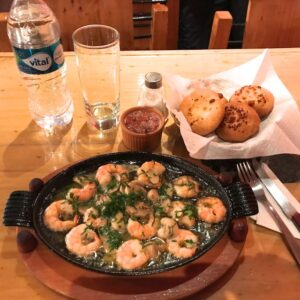
Fortunately, one of those photos was of the sizzling shrimp dish. I ordered that. It came with the shrimp actually sizzling in the skillet. Impressive. My meal was also served with some dinner rolls and a salsa.
At home Carol and I eat salsa several times a month. Normally, the hotter the better. I had been warned to avoid spicy foods because of the altitude. I dipped one piece of bread into the salsa and my mouth and lungs were on fire. That salsa would pretty much knock out any American salsa I’ve ever had.
I must have a cast iron stomach. I’ve always been able to eat anything and everything and often do. Most of my friends think KETCHUP is too spicy let alone anything they might find in a Mexican restaurant. Remember the “ass for every seat” analogy explained elsewhere.
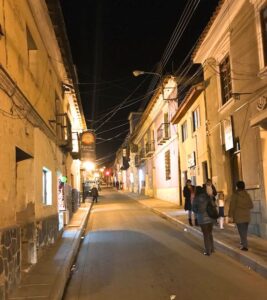
From the 460 restaurant I headed back to the hotel for my second night of sleep at 12,000 feet. I am happy to tell you that I slept much better than night number one. However, just walking around is still uncomfortable. I hope I continue to get more acclimated day by day. On Sunday, in four more days I’ll be at 14,000 feet.
Thursday – May 3, 2018
The first half of today would be a walking city tour of Potosi. Here are a few words from what Wikipedia has to say about Potosi.
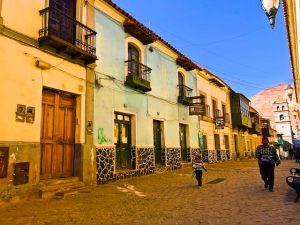
“Potosí is a capital city and a municipality of the department of Potosí in Bolivia. It is one of the highest cities in the world at a nominal 4,090 metres (13,420 ft).
Potosí lies at the foot of the Cerro de Potosísometimes referred to as the Cerro Rico (“rich mountain”) — a mountain popularly conceived of as being “made of” silver ore that dominates the city. The Cerro Rico is the reason for Potosí’s historical importance, since it was the major supply of silver for Spain during the period of the New World Spanish Empire.
The silver was taken by llama and mule train to the Pacific coast, shipped north to Panama City, and carried by mule train across the isthmus of Panama to Nombre de Dios or Portobelo, whence it was taken to Spain on the Spanish treasure fleets. Some of the silver also made its way east to Buenos Aires, via the Rio de la Plata.”
The officially quoted altitude of Potosi of 13,339 feet is a real butt kicker. I’m in the middle of day two at the high altitude. Knock on wood I have not been beset with severe headaches or nausea that actually makes folks bedridden for several days from altitude sickness.
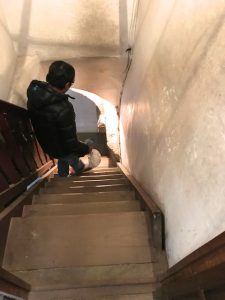
However, just walking up steps or uphill in general (Potosi has a lot of hills!) is a struggle. I had to carry my luggage up two flights of stairs yesterday. When I got to the top I felt I as if I had run the 100-yard dash, which I haven’t done since the 8thgrade by the way. I was huffing and puffing to beat the band. Additionally, maybe in a mental response to not wanting to exert myself too much I want to sleep more than normal. I’m pretty sure my mental sharpness isn’t normal either.
Frankly, this elevation sucks. Maybe that’s why I haven’t seen any American tourists and certainly none my age. I want to take the unusual trips so I have no room to complain.
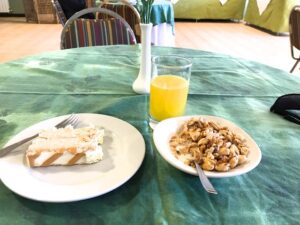
After having my hotel breakfast I met my tour guide “Michael” in the lobby. At each meal I’m trying to follow the advice from other Bolivian tourists. Eat lightly and don’t eat meat. If I don’t lose weight on this trip I never will!
Michael had a three-hour tour set for me. I paid extra to get a guided tour of each city I would visit. I didn’t want to miss a thing. My first tour in the town of Sucre was cancelled when the entire city went on strike.
The tour was just Michael and me. I like it that way. If I want to turn left rather than right on the tour I just tell my guide that’s what I want to do. I mentioned my plan to Michael and he was fine with it.
He spoke English well enough. Michael told me that most people work in the mines in Potosi. However, with silver prices way down as compared to 15 years ago pay is less as well. He told me beginning workers work inside the mines six days a week for $100/month. Think about that the next time you begin to complain about your workplace.
Workers can’t eat during their shifts in the mine. Why? There’s too much arsenic and dust in the air. Makes the old company cafeteria or brown bag lunch sound pretty good huh?
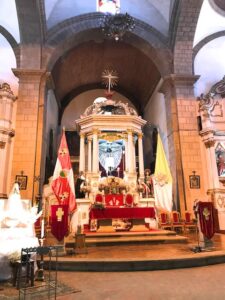
The highlight of the 1 ½ hour tour was visiting a convent. There was a beautiful cathedral inside the convent. By the way, did you know that I have a niece who is a nun in Rome, Italy?
There were a lot of irregular, narrow steps to climb inside the convent. This included winding staircases and stairs with no handrails. The foot boards were designed for the smaller Bolivian people and not for my size 14 New Balance power walking shoes.
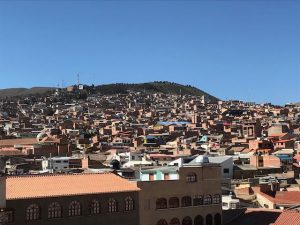
I’m a little bummed I brought both a summer and winter touring wardrobe. I could have easily done this trip with only shorts, t-shirts and a pullover. However, I didn’t know right.
Michael, my guide, worked in the mines for two years. Then his wife told him he had to quit. The work was just too dangerous. He told me with a tear in his eye that in Bolivia, “You’re not a man if you’ve never worked in the mines”.
Tourists can take tours of the mine. However, the walkways and openings are very small befitting the men who work there. I would never take that tour. I have some problems with claustrophobia. Additionally, I’m getting a little tired of having to duck my head everywhere I go in Bolivia.
I told you earlier my tour today was set for three hours. The last hour and a half was a formal guided tour at a museum in Potosi. Michael would not be part of that.
I’m not a huge “museum person”. I love automobile and Hall of Fame museums but that’s about it. I can breeze through certain historical museums in twenty minutes. I didn’t want to be tied down for 90 minutes going through today’s museum. Michael understood. I bagged the museum and bid Michael farewell. I would see him again in the afternoon when he picked me up at the hotel to take me to the bus station.
It was now 10:30 a.m. I was free until 3:30 p.m. In this altitude I had no interest in walking around. I went back to my room to take a nap! I set my alarm so there would be plenty of time for lunch.
I was going to be on the bus from Potosi to Uyuni from 4 p.m. until 8 p.m. I needed to eat enough to get me to Uyuni.
Last night’s dinner at the 460 restaurant was excellent. I could have easily gone back there. Nope. I don’t roll that way. I’ll only be in Potosi, Bolivia one day in my entire life. I didn’t want that 24-hour period filled with just one sit-down restaurant experience when I could have two.
Michael had recommended a restaurant to me for lunch. It was a long extremely downhill walk from my hotel. If I couldn’t find the cafe there would be a very uncomfortable uphill walk with nothing to show for it. I would try anyway. I couldn’t find the place. Then I had that uphill walk! Dang, I hate it when that happens.
I was attracted to a sandwich board sign outside a restaurant on the walk back in the direction of my hotel. It advertised pasta. Pasta is one food highly recommended when you’re new to high altitudes.
I had noticed that several other restaurants were closed for lunch for siesta. I walked right into the Potocchi eatery. They had about 10 diners in a place that might normally seat twenty. Potocchi had a good vibe.
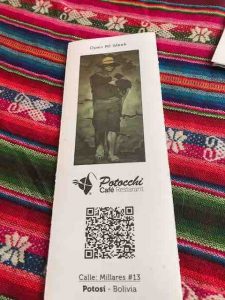
Their menu had a QR bar code on it. I clicked on the bar code and soon was directed to the TripAdvisor comments from previous patrons. I had indeed stumbled upon a 4.5-star restaurant.
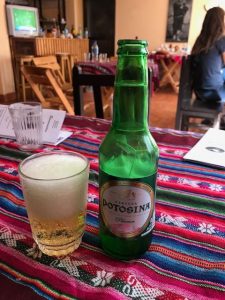
Soon I was ordering a local beer, Potosina. Alcohol is not recommended for newbies to high altitudes but what the heck. I followed with an order of spaghetti carbonara. Everything was very good. What was the cost of a beer and a pasta dish? The answer: a little bit less than $8 USD.
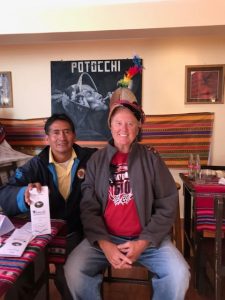
The reviews all talked about the friendliness of the owner. They were right about that. He shook the hand of every diner leaving his establishment.
One does have to take each review with the proverbial grain of salt. It’s interesting to read the one-star reviews. Some of the things people complain about and take the time to write a review on are simply comical and/or ill-informed.
A few people complained about the prices being high. For gosh sakes where can you get a bottle of beer and a quality serving of spaghetti carbonara for less than eight bucks? Others said the servings were small for the price. The size of my portion was on par with what I would find in an American Italian restaurant and American restaurants are famous for serving large portions.
I lone ago learned that people just think differently about the very same thing. As I looked over a used car lot one day I noticed a lonely bright pink rather forlorn sedan sitting in the back row of the lot. I asked the salesman who would ever buy that car. His answer taught me a lot. “There an ass for every seat,” he told me. That one simple statement can be applied to so much in life.
At 3:30 p.m. Michael came to my hotel to take me to the bus station. My bus to the town of Uyuni was leaving at 4 p.m. I had only left Uyuni yesterday at 1:30 p.m. My tour wasn’t supposed to be that way. However, when the town of Sucre had a city-wide strike my tour had to be “adjusted”. One of my drivers told me that a city wide “civic” strike simply shuts down the city. Virtually everyone in town demonstrates by clogging streets with their cars and bodies. Nobody can go anywhere.
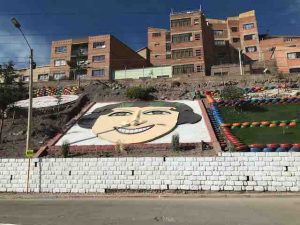
When Michael gave me my bus ticket he told me I had seat #12. I had no idea there were reserved seats. Yesterday, with less than ten passengers on the bus I simply sat anywhere I wanted.
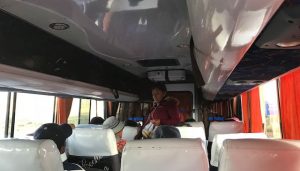
Today’s 32-passenger bus, would have no bathroom mind you for the four-hour trip, was nearly full. I still had no idea where seat #12 was. Again I sat in a spot that looked comfortable. Despite passengers getting on and off the bus at various stops during the trip no one felt like bothering the one and only grande amigo on the bus!
During yesterday’s bus ride they didn’t play any music. Today they did. It was all lively upbeat Spanish music. I felt like I was on the party bus to Uyuni!
Much of the ride was in the dark. The bus stopped from time to time to either drop off riders or pick up new passengers. The driver simply pulled off to the side of the road to do this. It seemed as if people were just standing out in the middle of nowhere in total darkness when the but stopped to pick them up!
The only animals I’ve seen during the past two days of bus rides have been llamas. They raise them like cattle. Llama is on the menu of many Bolivian restaurant menus. From time to time they wander across the road. The driver blew his horn several times and slowed to avoid them.
I spent most of my time on the bus with my laptop. I always have a few Apple iTunes movies on my computer. You never know when you will have some time on your hands. Tonight, I had four hours to kill.
I am partial to documentaries. I watched a movie titled, “Peter and the Farm”. It’s about a Vermont farmer who is very resourceful but also very difficult to live with. I found it entertaining.
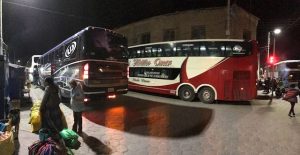
When we arrived at the bus station there were probably a dozen buses or more in various stages of departing or arriving. I think several of the buses were bound for overnight journeys. It was nearing 9 p.m. I had not expected the bus “terminal” to be that busy. Overnight bus rides are very common in Bolivia.
I would be staying tonight at the same hotel I had stayed in two nights ago. I will tell you this. Tonight is my third night of sleeping at a high altitude. I feel 100% better tonight, night #3, than I did the first night. I’m not declaring victory over altitude sickness, I’m simply saying I’ve felt better each day.
The hotel gave me the same room I had on Tuesday night, room #101. They had already moved the bag I stored with them when I left into my room. That was great customer service. It was good not lugging that bag around for the past 36 hours.
I elected to get a light supper in the hotel dining room. I don’t normally eat dinner in hotel restaurants. It’s all about core competencies. If they are a good hotel can they be as good or better than a business that is a restaurant only. I don’t normally think so.
Nevertheless, I didn’t want to go outside the hotel for the light meal I was looking for. This was a very good decision.
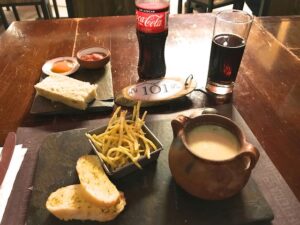
I ordered the “peanut” soup. It came with shoestring fried potatoes, two pieces of garlic bread and more bread and dipping sauces. For the first time since I’ve been at a high altitude I had half a bottle of Coca-Cola Zero. Coke Zero is not often found in South American cities. Quite often they just stick with regular Coca-Cola.
Food in nice Bolivian restaurants is incredibly inexpensive. Tonight my meal tab came to a grand total of 40 bolivianos or about $5.80 USD. I’ve found the restaurant food prices to be about one-third of what I would pay for a comparable meal in the U.S. That’s outstanding.
I hope my good fortune continues with regard to altitude sickness. I’m already starting to back off of some of the things that probably contributed to my success. I guess that’s human nature.
This is Wikipedia’s opening comment about where I will be touring tomorrow.

“Salar de Uyuniis the world’s largest salt flat at 10,582 square kilometers (4,086 sq mi). It is in the Daniel Campos Province in Potosí in southwest Bolivia, near the crest of the Andes and is at an elevation of 3,656 meters (11,995 ft) above sea level.”
Friday – May 4, 2018
I’m feeling more and more comfortable with the high altitude of Bolivia each day. I’m not ready to run a four-minute mile but each day is better.
Today is the big event of the in between race weekends days dedicated to touring. We will have an all-day tour of “Salar de Uyuni”. This is the biggest salt flats in the world. It’s 4,086 square miles in size at 11,995 feet. The Salar de Uyuni contains 50-70% of the world’s lithium reserves. Who knew? By the way the famous Bonneville Salt Flats (I’ve seen racing there) is 40 square miles in size or 1/100 the size of Salar de Uyuni.
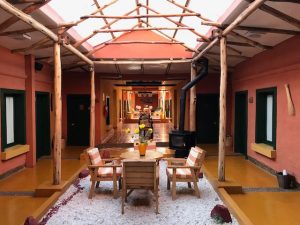
I woke up this morning to a very good complimentary breakfast at the Hotel Jardines of Uyuni. They even fried up some eggs for me. The hotel selection provided by my travel agent, Lucia from the Kimkim travel agency has been outstanding. Well done Lucia.
She had booked me on the all-day tour to the Salar de Uyuni. It would turn out to be the touring highlight of the trip. Lucia had covered all of the bases. My tour package included a driver to move me from airport to hotel to bus station to tour spot and any combination of these. Since there is very little ingles spoken in Bolivia that’s an absolute requirement.
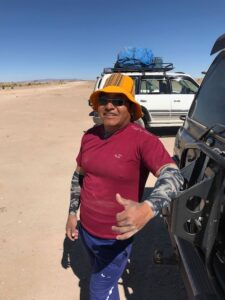
I was booked on a tour with a Spanish speaking only tour guide (above). Our tour vehicle would be a Toyota 4-Runner. In that car we had the driver, me and five other pretty much Spanish only speaking folks. Luckily, I got to sit shotgun in the front seat.
Some folks reading this might not like the idea of being on a tour with no English being spoken. I can understand that. Most people take a vacation or two each year. They want everything to be absolutely perfect. I don’t shoot for perfect in much of anything. Perfection takes too long to achieve and can be a major source of frustration. I’ll look for perfection in airplane take offs and landings. For salt flat tours I’ll accept very good. That’s what I got today and I was more than satisfied.
If you’ve ever seen a huge snow-covered lake in the winter then you’ve pretty much seen what a large salt flat looks like. Looking at either you would be hard-pressed in a split second to say for sure if what you were seeing was a salt flat or a snow-covered lake in the winter.
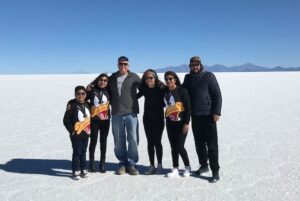
We probably drove out onto the salt flat for thirty miles or so. From time to time our driver stopped. We would all get out, take photos and just admire the situation.
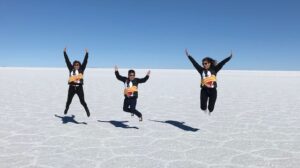
Even though the other six didn’t speak virtually any English we used hand gestures when we needed too. I did take two years of high school Spanish. I had ZERO interest in the subject. My semester scores of 70-72 for four semesters reflected two things. First, I had no interest in learning Spanish. I didn’t know a single person, I had never met a single person…who spoke Spanish.
What’s the second reason my Spanish scores were what they were? I was a basketball player. I’m not sure I fully earned my scores of 70-72. However, Senora Korngabel, rest her soul (probably) was in constant communication with the basketball coaches.
During one semester, divided into three grading periods, I recorded grades of F, B and F. The first “F” was before the basketball season started. The “B” came during the basketball season. The final “F” came after the bball season had ended. You can do the math right?
By the way, I can tell you this now. High school basketball is a pretty big deal in Illinois. We played in the conference that yielded the state champion in 1967. At that time there was only one class and that class included every high school in the state of Illinois. There were about 750 schools. When I went to the barber, if I had scored a certain number of points in the last game my haircut was free. If I had scored a certain number of points in the game my girlfriend knew we could go out after the game. It was my world but people knew me there.
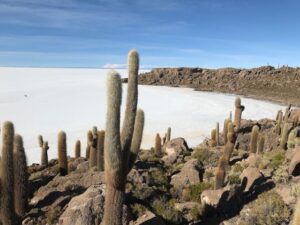
I had no idea we would be visiting a National park on today’s tour. Yep. The Incahuasi park was located right out in the middle of the 4,000 square mile salt flats. Just hiking to the top of the island park at this elevation was a huge change, but I made it to the top. Don’t miss the photos.
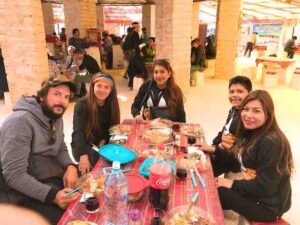
Even though our guide didn’t speak any English I did not feel disadvantaged at all. Most things of historical significance that an English speaking guide would have told me would have been forgotten by the end of the day anyway. Despite speaking different languages we had a nice lunch together.
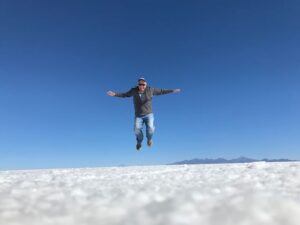
Our guide was very good at arranging “photo ops”. Check out the above photo. There is no trick photography. It’s just me, the guide, my iPhone and the Salar de Uyuni salt flats. Pretty cool huh?

When the all-day tour was finished the guide dropped me off at my hotel for the night. I was staying at the Palacio de Sal. This was the first salt hotel ever built in the world. The other passengers on my tour went off to parts unknown.
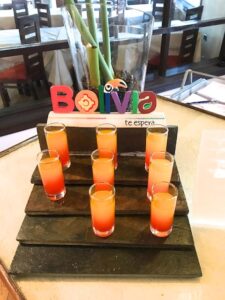
The Palacio de Sal was indeed impressive. It sits at the edge of the salt flats. The entry is something to behold. When I check in they gave me a welcome drink of some red and orange concoction. It hit the spot.
The first thing I did was to go outside and walk about a mile. I needed that to get my four miles of power walking in for the day. The sun sets at just past 6 p.m. On my walk back to the hotel the setting sun over the salt flat was most picturesque.
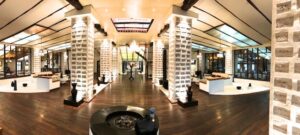
All of the walls in this hotel are made of salt. I don’t know if they built the hotel using normal wooden/steel construction and then filled in the salt around that or if the entire place is simply salt! The “box springs” on my bed were one big 6’6” x 4’ x 12” block of salt. All of the amenities of this hotel were upscale. It was a fine place to stay.
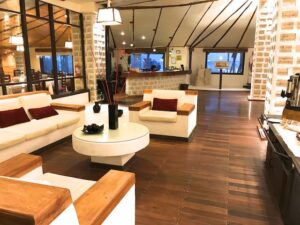
I made a reservation for dinner in the hotel restaurant. There really weren’t any other options for eating. There was nothing near the hotel other than the salt flats for a few miles.
I was beginning to feel pretty comfortable with the altitude. That seemed to mean to me I could begin to drink alcohol and eat more food. That was my interpretation of things anyway!
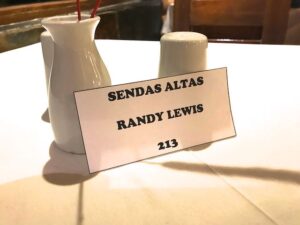
When I walked into the restaurant my table was reserved. They even had my name on a placard at the table. I started out with a Pisco sour. I first started drinking those when Carol and I visited Peru. It’s there national drink.
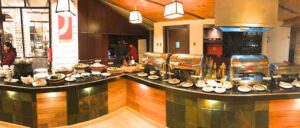
Then I hit the buffet table. This was the first time in a few days that I was beginning to eat “normal”. Everything was delicious. Please don’t miss the photos of the Palacio de Sal. Tomorrow it’s on to the airport for a visit to La Paz and more racing. Can’t wait.
Saturday – May 5, 2018
I’m on the back side of this trip now. It’s day #11 of the 13-day trip. Today I fly from Uyuni to La Paz, Bolivia. La Paz is the third biggest city in the country.
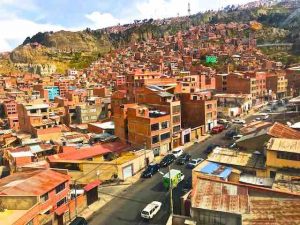
La Paz is the capital city of the Plurinational State of Bolivia. The city has a population of about 800,000 people behind the populations of only Santa Cruz and El Alto. At an altitude of about 12,000 feet, La Paz is the highest capital city of any country in the world.
Checking in at the Uyuni airport was a trip. The entire place is about the size of my modest seaside cottage! I didn’t see a single car parked at the airport, only a few taxis waiting for arriving passengers.
I was only allowed 20 kilograms of weight for my two checked bags. It didn’t seem to matter that I was checking two bags and not one. All of my checked baggage weighed in at 26 kilos. I had to pay 54 bolivianos for the extra weight. That’s only $7.50 USD. Not bad. In the U.S. I would pay $25-50 for an extra bag. There was an $11 boliviano airport departure tax or about a buck and a half. Why bother?
I had flown into Uyuni from Santa Cruz on a very small propeller driven plane earlier in the week. There was only one seat on each side of the aisle. The floor to ceiling height was about five feet. I hadn’t flown on one of those little guys in a very long time.
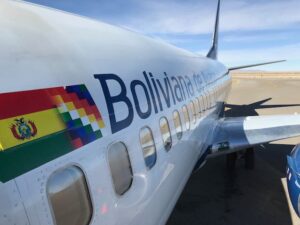
Today I was flying on Boliviana de Aviación (BoA), a first for me with that airline. They were using a Boeing 737-300. As you know our son, J.J. is a commercial airline pilot. His airline limits their take offs and landings for their Boeing 737s to 8,500 feet in altitude. Today we were taking off from about 12,000 feet! What was up with that.
I had a cramped aisle seat in coach. The plane only had coach seats. I asked the flight attendant if I could move over into the exit row that was wide open with lots of legroom. He asked me if I spoke Spanish. That seemed like an odd response to my question. It wasn’t. If I didn’t speak Spanish I couldn’t sit in the exit row! In the U.S. if you can’t speak English you can’t sit in the exit row. Fair enough.
I landed at the El Alto International Airport (LGB). The city of El Alto is only 33 years old. It grew from the population growth of the capital city of La Paz just eight miles away. The airport sits at a nifty elevation of 13,325 feet. LGB is the highest international airport in the world and the fifth highest commercial airport anywhere. Folks, that’s high!

My driver Juan was waiting for me upon arrival. When I said something to him he told me to speak Spanish only Spanish. That wasn’t going to happen. Juan was older and I could see he was a practical man. When I informed him, “No hablo Espanol” we both understood where we were at! No problem. We made it work.
The city of La Paz sits down in a big bowl with El Alto looking over it. The drive into the city from the airport was one of the most amazing things I had ever seen.
Imagine your morning cereal bowl. Now imagine a home of some sort on virtually every inch of the interior of the bowl including the steep sides. Now you’ve got La Paz!
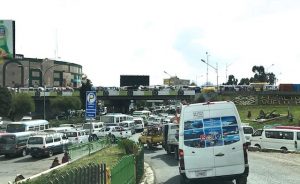
The traffic into La Paz and in La Paz is intense. Many, O.K., almost all of the streets are narrow. The driving strategy is very simple. No one gives anyone else a break. No one lets anyone else in front of them. This does make thinks simple doesn’t it. If you want to get in line you simply go for it and hope you have an inch or two advantage. Surprisingly I didn’t see any accidents today.
I would be staying at a place called the Amani Hotel Boutique. The people who own and run it could not have been nicer. My room rate comes with breakfast. Breakfast begins at 7 a.m. However, for the two nights I’ll be staying here I will be leaving at 6:30 a.m. and 4 a.m. No hotel breakfast for me.
I spent some time talking with the owner. The hotel itself is his former childhood home. The man, in his thirties, took about six months to convert the huge home into a nine-room B&B. They’ve been open for about a year. He tells me they are full nearly every night. That comes from a 9.2 Booking.com hotel rating.
I had just enough time for lunch before my 2 p.m. city tour pickup. I figured I would go with pasta since that is reported to help fend off altitude sickness. By the way, so far so good with that. I’ve only got a day and a half to go and then I’ll be back at more normal altitudes.
Rosa, the able assistant at the Amani Hotel was most helpful. She was an older woman. When I say someone is “older” they might very well be and probably are younger than me. Remember, I am a 35 year old man trapped in a 69 year old body. When I look at these “older” people like Juan and Rosa today I view them through the eyes of a 35-year old.
Rosa spoke English and knew the value of having her job. She had the perfect pasta place for me just down the street. Great. The only thing not so great about her lunch recommendation is that the place was closed when I arrived.
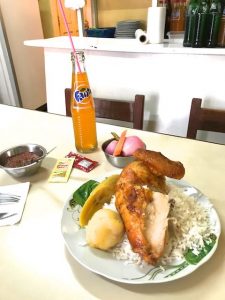
No problem. I scouted around and found a “pollo” chicken place a few doors down. It was the kind of place that 99% of the people reading this tale would not ever venture into. It was a hole in the wall within most hole in the walls.
Today I would be the only person dining inside. “Inside” could accommodate about eight people. It was a family affair. Dad was tending to the rotisserie chicken rotating in the window. Mama was carrying one small child “Papoose” style and two other “niño’s” under the age of five were running around. Don’t miss the pictures of this place.
I dined on half a chicken with both breasts. I’m a breasts man. My meal came with rice, a boiled potato, a fried banana (the only thing I didn’t care for) and some of the most unusual and tasty white/pink onions I’ve ever seen.
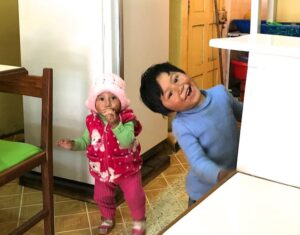
I downed everything with two glass bottles of orange Fanta drunk through a straw. My total bill came to 32 bolivianos. At an exchange rate of 6.9:1 USD that came to a bit less than five bucks in my currency. The meal was worth twice that. The experience was priceless.
I was back to the hotel in plenty of time for a 20-minute nap. Some people wonder how I can travel and keep the hours that I do. Napping. That’s right. I’ll grab a nap whenever and wherever I can.
Promptly at 2 p.m. driver Juan and today’s tour guide Ximena were waiting for me. Rosa came to my door at 1:58 p.m. to make sure I would be on time. She’s old school. Most older people are. Lots of time I don’t really care for old school type thinking. However, I like to be on time and that’s old school.
Juan was driving the same vehicle he picked me up in at the airport. It was a huge nearly new van similar to the rental car pickup vans used at major airports. It could probably seat 12-15 people or so. Today it was just Juan, Ximena and me. Fair enough.
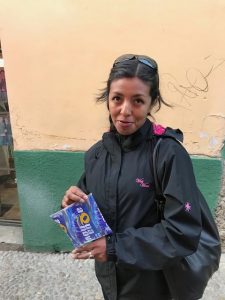
Ximena was an excellent guide. She was a single 31-year old female who was most knowledgeable on any and every aspect of La Paz that she wanted to talk about or that I wanted to ask about.
Before I met up with this duo I found an indoor local meat market. Boy, did they have the meat. Don’t miss the photos.
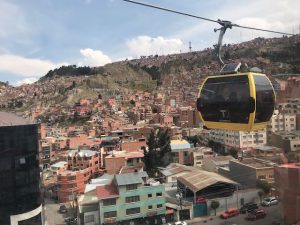
My first adventure with Ximena (pronounced him-a-na) was a visit to the cable cars of La Paz. Most big cities have a mass transit system featuring a subway or train system. La Paz has cable cars. They have different lines of cars identified by color. Today we rode on the green and yellow lines of cable cars. It doesn’t cost much to ride them. Each car holds about 10 people. La Paz is the only big city in the world that uses cable cars as part of a mass transit system. The views of La Paz from the cable cars are so expansive it’s difficult to capture them in a single photograph.
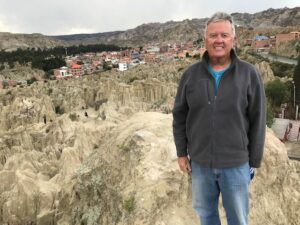
Following the cable car adventure Juan drove us to “Moon Valley”. Over the years rain and wind has eroded this valley of clay into a most unusual topography. Astronaut Neil Armstrong saw this area from the moon itself and labeled it “Moon Valley”. Ximena and I went hiking, again at 12,000 feet all over Moon Valley. Do not miss the pictures on this one.
From there we went to the city centre of La Paz. La Paz is the working capital of Bolivia. At first glance La Paz seems to have a much greater population than Santa Cruz where I visited last week. Wrong.
The population of La Paz is 800,000. In Santa Cruz the urban population is 1,442,000 people. It’s just that in La Paz the people are really packed into a “bowl”. Santa Cruz is like Los Angeles is a way. It is spread out with a city centre that truly is smaller than that of La Paz. However, Santa Cruz has some sprawl to it.
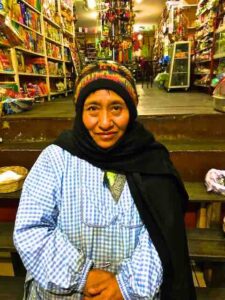
After having Ximena describe the history and current day activities of La Pax we ventured over to what is known as Witches Market. This is a series of streets all devoted to “trading”. When it’s time to find that really cool Bolivian souvenir Witches Market is the place to go. The people watching is a big deal here too.
Ximena did something that in all of my travels I had never seen done before. She drank her water from a plastic bag. Imagine a plastic bag that might contain marshmallows. That’s the kind of bag she drank from. I had never seen anything like it. It didn’t look all that convenient but she told me it saved the cost of plastic and she is charged only 50 cents for it.
When I go on these tours I ask any question that pops into my head. I have been known to interrupt a long discussion about something that happened in the mid-1800s with “What’s the favorite car of choice here”.
Today we got onto the topic of the cost to Americans for a Bolivian visa. It’s $160 USD for a 10-year visa to Bolivia by the way. Ximena told me that fee came in when President Emo Morales was elected. He’s been in office a bit more than ten years.
The president before Morales held a dual Bolivian-U.S. citizenship. He didn’t last long according to Ximena. The old president allowed U.S. Drug Enforcement Agents into Bolivia to control the production of coca leaves often used in the production of the drug cocaine.
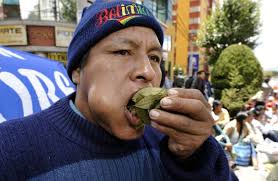
Ximena told me it is a Bolivian culture, that’s been going on for centuries, for Bolivians to chew the coca leaves like someone in the U.S. might chew tobacco. She felt it was the right of Bolivians to continue to chew coca leaves even if cocaine production came along with it. I wasn’t sure I was with here on that. O.K., I wasn’t with her on that.
At the end of this four-hour tour at such a high elevation I was tired. I had walked 3.2 miles. On most days when I’m that close of my daily goal of four miles I simply keep walking somewhere until I meet my goal. When today’s tour was finished I grabbed something to eat for supper and headed to bed. Tomorrow was a big day for me in Bolivia. It was race day!
Sunday – May 6, 2018
I woke up at about 4 a.m. Today was race day! I love saying that in a foreign country. Did you know that the percentage total of foreign tracks out of all the tracks I’ve seen in total hovers between 14-15%? It’s been that way for years.
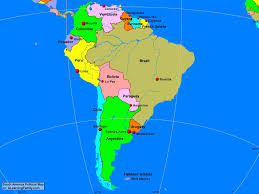
I’ve seen more countries and tracks in South America than any other trackchaser. When the sun sets tonight I will have seen 11 tracks in nine South American countries. I had to go to South America nine separate times to make that happen.
I would be leaving the hotel by a taxi that I hoped Rosa, the hotel manager had arranged for me at 6:30 a.m. I would need thirty minutes to get ready. I didn’t need to be getting up at 4 a.m.!
I used about an hour of that time to write more of this Trackchaser Report. Then I went back to bed and slept from 5 a.m. to 6 a.m. Yep. Time and sleep management.
You might have guessed. The taxi Rosa was to have arranged never showed. I had to meet my Bolivian counterparts about three kilometers away at 7 a.m. If I missed that bus I was in trouble.
The overnight desk clerk was sound asleep at his post. I roused him. He didn’t speak any English. Nevertheless, through sign language and pigeon Spanish he got the idea I needed a taxi and there was no time to waste. The taxi came in five minutes.
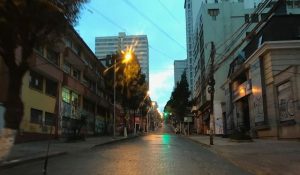
I had thought ahead to get this morning’s destination directions written into my phone in Spanish. That helped a lot with my taxi driver. At this hour there was no track. Soon I was arriving at Hernando Siles Stadium.
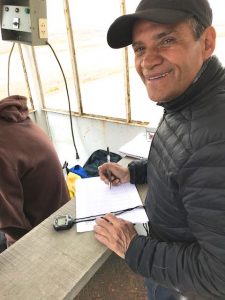
My main contact Sergio Kosky Herrera had arranged for me to ride the “journalist’s” bus. The guy in charge of that was Raul Espada (above). Raul spoke English. I had spoken to him on the phone using WhatsApp. Tech helps me more and more every day.
Raul organizes a mini bus to take La Paz racing journalists, newspaper, internet and radio, to the Autodromo de Pucarani for every one of the four race weekends each year. This assures the track gets the coverage it so sorely needs.
I met Raul and his bus driver Marko at the stadium a few minutes past 7 a.m. As we made the 24-mile drive from the city centre of La Paz to the track we picked up one person after another. A couple were late and frantic phone calls were made until they arrived. One woman missed the bus entirely. In total there were about ten people riding the journalist’s bus today. Except for Raul not many people spoke much English at all.
Raul was a kind and friendly person. We talked back and forth during the entire ride. It was only a 24-mile trip but it took us about an hour to complete. The roads are not great. They are clogged with traffic. It’s pretty much every man for himself if you expect to drive here.
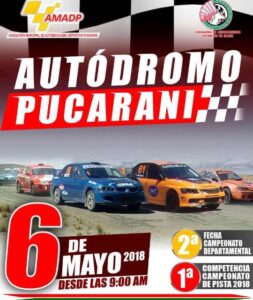
The race schedule was explained to me. We would get to the track at a little past 8 a.m. “Classification” would take place at 9:15 a.m. The first race of the day was set for 10:30 a.m. The second and final race of the day would be at 12:15 p.m. Raul told me “We leave as soon as the last race ends”. That wasn’t exactly accurate. I’ll tell you why later.
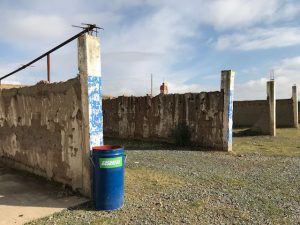
I was told the Autodromo de Pucarani first started having racing in 1998. The facility looked older than that. I was also told the government owns the track but they don’t maintain it well. The drivers come out the day before the race to fill potholes and the like.
I would have full run of the place. There was no admission charge for me or for anyone. Drivers pay a fee to race but race for trophies and no prize money.
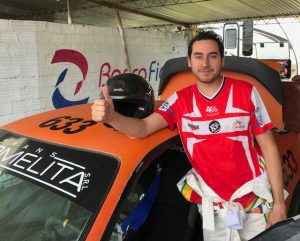
This would be my first chance to meet Sergio Kosky Herrera. Sergio and I had been corresponding for more than one year. We did virtually all of our communicating in Spanish. Since I don’t speak Spanish I used a translator. I hate to share all of this secret stuff because my fellow competitors read every word and seem to commit it to memory. Nevertheless, if they are willing to take the adventuresome steps I do in these trips (they aren’t) then more power to them in reapplying my techniques.
Sergio was as glad to see me as I was to see him. He is the younger of the racing Kosky’s. His dad Sergio Kosky Vacaflor has been racing in Bolivia and the United States for 30-35 years. The best analogy I can make is that the Kosky’s are the Bolivian racing equivalents to Dale Earnhardt Sr. and Jr. That’s a huge compliment.
Today the elder Kosky had the field covered. He set fast time. Then he started on the pole of both races and won each one easily.
I began the day making a complete tour of the paddock area. With just 12 cars racing that didn’t take too long. The Kosky family seems to be the leader when it comes to supporting the series. Today, in advance of the classification runs they were providing complimentary sandwiches and drinks to everyone.
Lots of folks came by to say “Hola”. One young driver was introduced to me as the Bolivian karting specialist. Another fellow gave over to meet me named Alex Rodriquez aka A-Rod. Alex spoke English well. I would say that well over 90% of the people in attendance did not speak any English.
Alex had lived in Seattle for 25 years before returning to Bolivia to care for an ailing parent. Actually, Raul had lived in Virginia for 10 years before coming back to his homeland to care for a parent. That’s where those guys got their English capability.
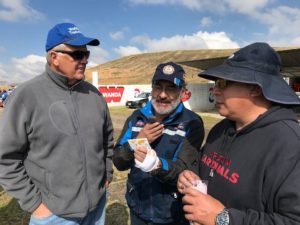
Alex (above right) would help translate for me today. I did a nearly five minute live radio interview with one of the radio guys, Rafael Vásquez (center) of Pure Energy radio. He and his sons had come to the track in the journalist’s bus. Much of the five minutes was the interviewer posing his question and then Alex translating it to me and then translating my answer back to the interviewer! Today’s interview reminded me of the live radio interview I did during my visit to Colombia while riding in a car to the track. Yep. I’ve had some unique adventures doing this hobby all over the world.
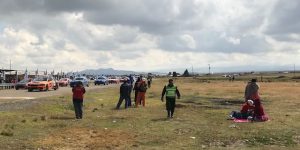
I watched the first 10-lap race from the infield of the track. There are not many safety barriers separating the cars from the spectators. There is one rail of steel Armco fencing that separates the cars from the people in the paddock. There were no barriers between the actual track and spectators watching from the infield.
They only have circuit racing at the Autodromo de Pucarani over four weekends each year. The rest of the time the grassy infield appears to be a cow pasture. I had to watch where I stepped.
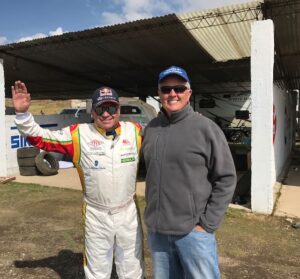
I hope you get the chance to watch my racing video from Pucarani. I was only feet away from the cars when the green flag flew. Sergio Kosky Vacaflor (above) led the field easily. His car was quieter than most but also faster than all.
There was a great battle amongst cars running from second to sixth. Each lap, in both races, they all changed positions. Sergio Kosky Herrera did a really good job driving a non-turbo car against all of the turbos in the top six. These five cars put on some particularly good racing.
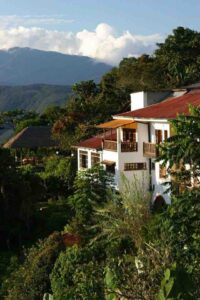
During the break I spent some time talking to Alex Rodriquez. He owns and operates a 15,000-acre farm in the Yungas region of Bolivia. He described the location as being “third world and out in the jungle”. He was heart-broken that today was my last full day in Bolivia. He insisted I stay with him during my next visit. I do have a 10-year visa for Bolivia. Who knows?
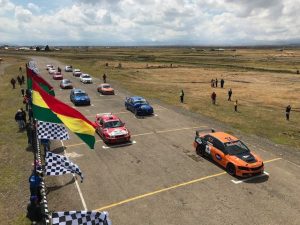
For the second race I watched the start from the top of the scoring/starting tower. I can’t emphasize enough how knowing the local people and getting the perks they can offer increases the enjoyment of these races.
When all of the racing was finished it was time for “prize-giving”. The top three finishers in each class received trophies, applause and recognition from their peers.
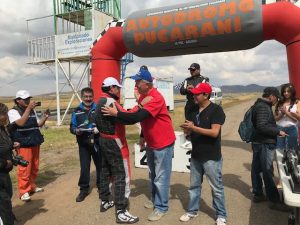
I was selected to give some of the trophies to the drivers. That was a treat. Then when all of the driver trophies had been handed out I was called to the front of the stage again.
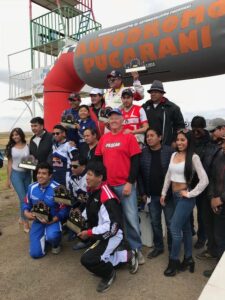
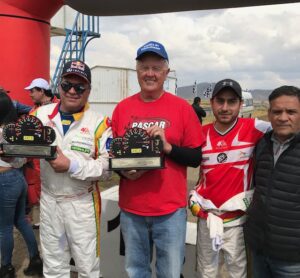
Sergio Jr. presented me with my very own racing trophy as a remembrance of my visit to the Autodromo de Pucarani. That was special, very special. Thank you, Sergio! Gracias, Sergio!
Now it was time to head home. Raul began to gather up all of the journalists. That job was a bit like herding cats. It took a while before we got our bus filled and were driving in the direction of La Paz.
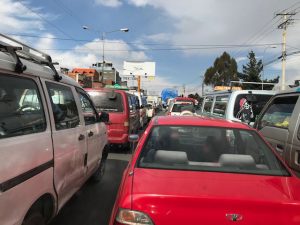
The traffic was beyond horrendous. The road in our direction was about four lanes wide. That was just wide enough to fit about FIVE rows of cars. Nobody in Bolivia lets the other guy in. I would hate to be an auto insurer here. Our driver Marko, who drives the journalist bus on every racing trip, was a real pro. Well done Marko.
Raul and I were the only ones on the bus speaking English. I passed out the remnants of my Bolivian like package of Oreos. They went fast. The drive took the better part of 90 minutes. As we got closer to where I boarded the bus we began to make stops to let one or two people off.
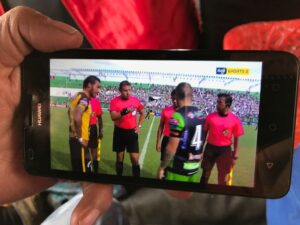
During the ride Raul showed me he can watch futball (soccer) games live on his phone. He also periodically shared the scores of all of the important Bolivian games going on today with the rest of the bus.
In a really nice gesture, when just Raul, Marko and I were left on the bus, Raul instructed the driver to take me directly to my hotel. Today I was a V.I.P. The kindness and generosity of these Bolivians made that happen. I felt inadequate. All I could give in return was a heartfelt thank you.
When I got back to the hotel I met up with Rosa, the older hotel manager. She spoke English pretty well. I never got the chance to ask her where she got those skills.
I had two questions for her. First, I couldn’t recall if I had paid for my room on line in advance or not. Secondly, I wanted a dinner restaurant recommendation.
The answer to the first question was, no I had not yet paid for my room. I offered up my Visa card. Rose told me their credit card machine had broken last week. I wish I had ten dollars for every business that has told me their credit card machine is broken. Honoring credit cards costs the local businesses an extra fee. I think a few people who have told me their credit card machines were “broken” might have been telling me a story as we used to say back on the block.
Rosa told me that I could pay her cash. The fee for two nights at the Anami Hotel Boutique was only $100 USD in total. However, I pushed back. I told her I didn’t have a free $100 in cash. She recommended I go to an ATM. Nope. I said I wasn’t going to pay an ATM charge because their machine was broken.
I gave Rosa all of my credit card info. I told her to use the numbers to get the bill paid. She said she would try. Then she gave me a recommendation for a pasta restaurant (carbs are a good altitude sickness fighter) and I was off.
I was back to the hotel and in bed by just past 8 p.m. It had been a very rewarding day. I had managed the racetrack’s 14,000 foot altitude with no problems whatsoever. I had met so many nice people. The weather had been perfect and the amount of racing just right. The trip to Bolivia had been nearly perfect.
My wake-up call was coming at 3:30 a.m. I would need to sleep fast. I would be traveling for 24 hours straight tomorrow.

Major thanks to Sergio Kosky Herrera. All of our messages in Spanish over the past year plus had paid off. Major thanks also to Raul Spada. He went out of his way to make sure my day was a success. Thanks to A-Rod for the translating and to Rafael for the interview. Thanks, guys.
Monday – May 7, 2018
It’s day #13 of this trip. I hope that’s a lucky number. Juan, the driver I first met on Saturday at the El Alto International Airport (La Paz) was waiting for me outside my hotel this morning at 4 a.m.
That’s 1 a.m. California time. I’ll be lucky if I get home by 1 a.m. TOMORROW in San Clemente. I guess if I don’t make it by midnight then this is a 14-day trip! My expected travel time from my hotel in La Paz to my driveway in San Clemente will be 24 hours. If you’re gonna do what I do then you’ll have to do it pretty much like I do. I try to balance cost effectiveness with convenience and try to maximize both. Sometimes that is not possible.
My first of three flights today, from La Paz to Santa Cruz was easy. I slept for the entire one-hour flight on Amaszonas Airlines.
Once in Santa Cruz I would have some problems with airport security. I am generally a strong supporter of airport security including the TSA in the U.S. They’re doing their job to try to keep everyone safe.
What I don’t like is the inconsistent application of the rules. When I have questioned airport security in the past on this their reply has been, “We just want to keep everyone guessing so the bad guys don’t win”. I think that answer is complete bullshit! If a rule is in place then it should be applied to everyone equally.
I must admit that getting every employee in every business to administer the company’s rules and regulations is impossible. Companies are dealing with human nature. Actually, as a person who tries to exploit every loophole in order to gain an advantage, I thrive on finding that employee who might “look the other way” when it is too my advantage.
Today, Santa Cruz airport security had a problem with me carrying the trophy that Manolo Chavez gave me. It’s a heavy wooden trophy constructed in the shape of a cross. Today’s crew thought it could be used as a weapon. Well….it probably could. Security at La Paz earlier this morning had no problem with the trophy.
That meant I would need to put the trophy in my checked baggage. The problem was I had already checked my one and only bag about 20 minutes ago. I went back to the gate. What could we do? They would try to retrieve my checked bag.
Folks, I have flown on 2-3 flights on average each and every week since I was twenty-three years old. That’s almost 6,000 flights and my estimate is probably low. What happened today had never happened to me before.

I was taken back into the recesses of the airport baggage area. I had to trade my passport for a security badge. I had to wear an orange security vest. When all of the cloak and dagger stuff was in place they found my bag. I rearranged my dirty laundry to accommodate the trophy Manolo had given me.
If they had not been able to retrieve the bag I had already checked they said I would have to leave the trophy behind. That wasn’t going to happen. If need be I would have purchased another travel bag in the airport to transport the trophy. If Manolo thought enough to give me the trophy I was going to guard it and get it back to San Clemente one way or the other.
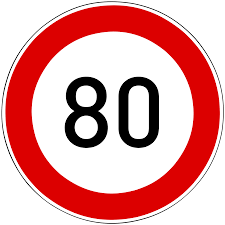
Prolog
I have now seen racing in 80 different countries. I’ve been to about ninety countries in total. What have I concluded from all of this travel? I like living in the United States. I love the U.S.A.
However, all of this travel has given me a much greater appreciation for other people and other cultures. I think if everyone living had as much travel experience as I have then people with different skin types and religions would not be nearly as threatening.
I’ve learned that people who don’t have as much to give often give the most. I like that about what I’m doing. I’ve learned that people who don’t stand to gain anything from my visit give the most of themselves so that I can enjoy what I do. I am indebted to virtually every person I have ever met on one of these trips.
As I look back over the list below the best country trips are when I met local people. In other countries where I simply marched into the country, watched a race from the grandstands and left were fun enough trips but they weren’t usually the best trips.
I cannot recall a single country visit where I didn’t have a good time. There are a few, far less than half, that get a perfect score. I won’t tell you which previous countries achieved that 100% rating. I think they know who they are.

Bolivia gets a perfect score, a top rating. They joined a few other countries whose hospitality, uniqueness and overall vibe was the best.


What was best about Bolivia? It wasn’t the world’s largest salt flats. That was pretty cool though. It wasn’t tours of places like Potosi and La Paz. It was the people who took me into their homes and cooked me meals. It was the people who basically “watched out” for me.
Let me tell you this. I really could do just about all of this without the help of anyone. However, if I did it that way it wouldn’t be nearly as fun. When I see someone “watching out” for me, even when I don’t need the help, I have great appreciation for the sacrifice that person is making to help me.
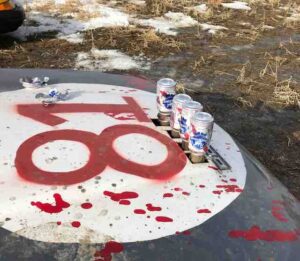
So, what about the future? Can trackchasing country #81 be far off? I wouldn’t be surprised if it happens in 2018. There are no guarantees. I just have that feeling. I have travelled more than 97,000 miles (155,000 kilometers) during the first four months and seven days of 2018. I think it’s time to see a few tracks in North America. I plan to do that.
Nevertheless, I’ve got some irons in the fire. I never know when the next “hit” will come. I have international friends who are just waiting to help. They will not be denied. If they want me to visit their country then I will. Stay tuned right here at www.randylewis.org and you won’t miss a thing.
Thanks for reading about my trackchasing,
Randy Lewis
World’s #1 Trackchaser
Randy is a freelance journalist who winters in San Clemente, California and sometime flies in coach.
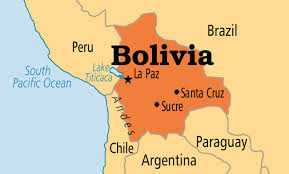
And so it goes from country #80, Bolivia.
THE COUNTRY LIST
#80!!
RLR – Randy Lewis Racing Lifetime Trackchasing Countries
# 1 – UNITED STATES OF AMERICA – Peoria Speedway – Mt. Hawley (oval) – Track #1, Peoria, Illinois – circa 1955
# 2 – CANADA- Cayuga Speedway (oval) – Track #174, Nelles Corner, Ontario – 1988
# 3 – AUSTRALIA– Parramatta City Raceway (oval) – Track #180, Granville, New South Wales – 1989
# 4 – UNITED KINGDOM– Northhampton International Raceway (oval) – Track #378, Northhampton – 1999
# 5 – NETHERLANDS– Driesum Racetrack (oval) – Track #839, Driesum – 2005
# 6 – BELGIUM– Bellekouter oval (oval) – Track #841, Affligem – 2005
# 7 – FRANCE– Circuit de Croix en Ternois (road course) – Track #843, Saint-Pol sur-Ternoise – 2005
# 8 – GERMANY– Nurburgring (road course) – Track #844, Nurburg – 2005
# 9 – NEW ZEALAND– Western Springs Speedway (oval) – Track #1,134, Western Springs – 2006
# 10 – MEXICO– Triovalo Bernardo Obregon (oval) – Track #1,281, Tiajamulco de Zuniga, Jalisco – 2007
# 11 – BARBADOS– Bushy Park Racing Circuit (road course) – Track #1,296, Bushy Park – 2007
# 12 – THAILAND– Bira Circuit (road course) – Track #1,300, Pattaya – 2008
# 13 – SOUTH AFRICA– Durban Grand Prix (road course) – Track #1,315, Durban, KwaZulu-Natal – 2008
# 14 – JAMAICA– Dover Raceway (road course) – Track #1,322, Brown’s Town St. Ann – 2008
# 15 – SWEDEN– Sturup Raceway (road course) – Track #1,335, Malmo – 2008
# 16 – DENMARK– Ring Djursland (road course) – Track #1,336, Tirstrup – 2008
# 17 – CZECH REPUBLIC– Automotodrome BRNO (road course) – Track #1,381, Brno – 2008
# 18 – AUSTRIA– Lambrechten Stock Car Track (road course) – Track #1,382, Lambrechten – 2008
# 19 – IRELAND– Tipperary International Raceway (oval) – Track #1,388, Rosegreen – 2008
# 20 – GUYANA– South Dakota Circuit (road course) – Track #1,390, Timehri – 2008
# 21 – CHINA– The Guia Circuit (road course) – Track #1,392, Macau – 2008
# 22 – COSTA RICA– Autodromo La Guacima (road course) – Track #1,398, La Guacima – 2008
# 23 – ANDORRA– Grandvalira Circuit (road course) – Track #1,404, Port d’Envalira – 2009
# 24 – ARGENTINA– Circuito Efren Chemolli (oval) – Track #1,406, Buenos Aires – 2009
# 25 – QATAR– Losail International Circuit (road course) – Track #1,408, Doha – 2009
# 26 – BAHRAIN– Bahrain International Circuit (road course) – Track #1,410, Sakhir – 2009
# 27 – UNITED ARAB EMIRATES– Dubai Autodrome (road course) – Track #1,411, Dubai – 2009
# 28 – COLOMBIA– Autodromo de Tocancipa (road course) – Track #1,415, Tocancipa – 2009
# 29 – SPAIN– Motorland Aragon (road course) – Track #1,416, Alcaniz – 2009
# 30 – PORTUGAL– Circuto de Murca (road course) – Track #1,417, Murca – 2009
# 31 – ICELAND– Kapelluhraum (road course) – Track #1,420, Hafnafjorour – 2009
# 32 – HUNGARY– Hungaroring (road course) – Track #1,426, Mogyorod – 2009
# 33 – SWITZERLAND– Hock Ybrig (road course) – Track #1,427, Hoch Ybrig – 2009
# 34 – ITALY– Vighizzolo d’Este Stock Car Track (road course) – Track #1,428, Vighizzolo d’Este – 2009
# 35 – DOMINICAN REPUBLIC– Autodromo Mobil 1 (road course) – Track #1,515, Santo Domingo – 2009
# 36 – MALTA– Ta’Qali Race Track (road course) – Track #1,521, Ta’Qali – 2010
# 37 – FINLAND– Lake Pidisjarvi Ice Track (road course) – Track #1,524, Nivala – 2010
# 38 – JAPAN– Suzuka Circuit (road course) – Track #1,530, Suzuka – 2010
# 39 – CHILE– Autodromo de Interlomas (road course) – Track #1,531, Temuco – 2010
# 40 – MOROCCO– Circuit de Marrakesh (road course) – Track #1,535, Marrakesh – 2010
# 41 – BRAZIL– Circuit de Caruaru – Aryten Senna (road course) – Track #1,540, Caruaru – 2010
# 42 – ESTONIA– Laitse Rally Park (road course) – Track #1,571, Laitse – 2010
# 43 – LATVIA– Bikernieki (road course) – Track #1,572, Riga – 2010
# 44 – GUATEMALA– Autodromo Pedro Cofino (road course) – Track #1,580, Alotenango – 2010
# 45 – EL SALVADOR– El Jabali (road course) – Track #1,582, Quezaltepeque – 2010
# 46 – ROMANIA– Bradu (road course) – Track #1,603, Bradu – 2010
# 47 – BULGARIA– Closed Route – Burgas (road course) – Track #1,604, Burgas – 2010
# 48 – SOUTH KOREA– Korea International Circuit (road course) – Track #1,605, Yeongam, Jeollanam-Do – 2010
# 49 – PHILIPPINES– Batangas Racing Circuit (road course) – Track #1,608, Batangas – 2010
# 50 – NORWAY– Lyngas Motorbane (road course) – Track #1,648, Lier – 2011
# 51 – MALAYSIA– Sepang International Circuit (road course) – Track #1,656, Sepang – 2011
# 52 – INDONESIA– Sentul International Circuit (road course) – Track #1,657, Babakan Madang, Boder – 2011
# 53 – LUXEMBOURG– Alzingen (road course) – Track #1,711, Alzingen – 2011
# 54 – POLAND– Tor Slomczyn (road course) – Track #1,713, Slomczyn – 2011
# 55 – SINGAPORE– Marina Bay (road course) – Track #1,714, Singapore – 2011
# 56 – URUGUAY– Piriapolis Grand Prix (road course) – Track #1,724, Piriapolis – 2011
# 57 – SRI LANKA– Pannala Race Track (road course) – Track #1,732, Pannala – 2012
# 58 – ECUADOR– Autodromo Internacional de Yahuarcocha (road course) – Track #1,736, Ibarra – 2012
# 59 – SLOVAKIA– Slovakia Ring (road course) – Track #1,745, Orechova Poten – 2012
# 60 – MONACO– Circuit de Monaco (road course) – Track #1,747, Monte Carlo – 2012
# 61 – CROATIA– Automotodrom Drobnik (road course) – Track #1,762, Rijeka – 2012
# 62 – PERU– Autodromo La Chutana (road course) – Track #1,802, Lima – 2012
# 63 – GREECE– Serres Circuit (road course) – Track #1,807, Serres – 2012
# 64 –RUSSIA– Moscow Central Hippodrome (oval) – Track #1,824, Moscow – 2013
# 65 –LITHUANIA– Marijampole Autocross Track (road course) – Track #1,842, Marijampole – 2013
# 66 –INDIA– Buddh International Circuit (road course) – Track #1,915, Noida – 2013
# 67 –GEORGIA– Rustavi International Motorpark (road course) – Track #1,916, Rustavi – 2013
# 68 –TRINIDAD AND TOBAGO– Larry Gomes Stadium (road course) – Track #1,928, Arima – 2014
# 69 –TURKEY– Istanbul Park (road course) – Track #2,035 Akfirat – 2014
# 70 – AZERBAIJAN– Streets of Baku (road course) – Track #2,037, Baku – 2014
# 71 – SERBIA– Usce (road course) – Track #2,224, Belgrade – 2016
# 72 – BOSNIA AND HERZEGOVNIA– Zaluzani (road course) – Track #2,235, Banja Luka – 2016
# 73 – PANAMA– Circuito Internacional de Panama (road course) – Track #2,290, La Chorrera – 2016
# 74 – ZIMBABWE– Bulawayo Motorsports Park (road course) – Track #2,291, Bulawayo – 2016
# 75 – NAMIBIA– Desert Raceway (oval) – Track #2,369, Walvis Bay – 2017
# 76 – MACEDONIA– Skopje Street Course (road course) – Track #2,386, Skopje – 2017
# 77 – UKRAINE– Autodrome Chayka (road course) – Track #2,387, Kiev – 2017
# 78 – BELARUS– Stadium Zarya (oval) – Track #2,421, Minsk – 2018
# 79 – MALDIVES– Hulhumalé Racing Track (road course) – Track #2,425, Hulhumalé – 2018
# 80 – BOLIVIA– Autodromo Santa Cruz (road course) – Track #2,429, Santa Cruz – 2018
The International Big 3.
- . Randy Lewis, San Clemente, California USA – 80
- . Roland Vanden Eynde, Vilvoorde, Belgium – 52
- . Carol Lewis, San Clemente, California USA – 43
It should be noted that I saw racing in my 9thSouth American country at the beginning of this trip. The next leading trackchaser has three SA countries…and that’s Carol. When I first started doing this I never could have imagined how it would turn out. This is my complete South American country list.
Argentina
Bolivia
Brazil
Bolivia
Chile
Ecuador
Guyana
Peru
Uruguay
LIFETIME TRACKCHASER COMPARISONS
The three most important trackchasing comparisons to me are:
Total lifetime tracks seen
Total “trackchasing countries” seen
Lifetime National Geographic Diversity results
Total Lifetime Tracks
There are no trackchasers currently within 640 tracks of my lifetime total. Don’t blame me.
- . Randy Lewis, San Clemente, California – 2,431
Total Trackchasing Countries
There are no trackchasers currently within 25 countries of my lifetime total.
- . Randy Lewis, San Clemente, California – 80
Current lifetime National Geographic Diversity results
- Randy Lewis, San Clemente, California – 4.47
Bolivia – FAST FACTS*
Provided by my friends at Wikipedia
Bolivia,officially known as the Plurinational State of Boliviais a landlocked country located in western-central South America. The capital is Sucrewhile the seat of governmentis located in La Paz. The largest city and principal economic and financial center is Santa Cruz de la Sierra, located on the Llanos Orientales(Tropical lowlands) a mostly flat region in the East of Bolivia.
Its geography varies from the peaks of the Andesin the West, to the Eastern Lowlands, situated within the Amazon Basin. It is bordered to the north and east by Brazil, to the southeast by Paraguay, to the south by Argentina, to the southwest by Chile, and to the northwest by Peru. One-third of the country is within theAndeanmountain range. With 1,098,581 km2(424,164 sq mi) of area, Bolivia is the 5th largest country in South Americaand the 27th largest in the world.
The country’s population, estimated at 11 million, is multiethnic, including Amerindians, Mestizos, Europeans, Asiansand Africans. The racialand social segregationthat arose from Spanish colonialism has continued to the modern era. Spanishis the official and predominant language, although 36 indigenous languagesalso have official status, of which the most commonly spoken are Guarani, Aymaraand Quechua languages.
Modern Bolivia is a charter member of the UN, IMF, NAM, OAS, ACTO, Bank of the South, ALBAand USAN. For over a decade Bolivia has had one of the fastest economic growths in Latin America, however it remains one of the poorest countries in South America. It is a developing country, with a medium ranking in the Human Development Index, a poverty level of 38.6 percent, and it is one of the top three safest countries in Latin America.
Its main economic activities include agriculture, forestry, fishing, mining, and manufacturinggoods such as textiles, clothing, refined metals, and refined petroleum. Bolivia is very rich in minerals, especially tin.
Etymology
Bolivia is named after Simón Bolívar, a leader in the Spanish American wars of independence. The leader of Venezuela, Antonio José de Sucre, had been given the option by Bolívar to either unite Charcas(present-day Bolivia) with the newly formed Republic of Peru, to unite with the United Provinces of Rio de la Plata, or to formally declare its independence from Spain as a wholly independent nation. Sucre opted to create a brand new nation and on 6 August 1825, with local support, named it in honor of Simón Bolívar.
The original name was Republic of Bolívar. Some days later, congressman Manuel Martín Cruz proposed: “If from Romuluscomes Rome, then from Bolívarcomes Bolivia” (Spanish: Si de Rómulo Roma, de Bolívar Bolivia). The name was approved by the Republic on 3 October 1825. In 2009, a new constitutionchanged the country’s official name to “Plurinational State of Bolivia” in recognition of the multi-ethnic nature of the country and the enhanced position of Bolivia’s indigenous peoples under the new constitution.
History
History of Bolivia
The Spanish conquest of the Inca empirebegan in 1524, and was mostly completed by 1533. The territory now called Bolivia was known as Charcas, and was under the authority of the Viceroy of Lima. Local government came from the Audiencia de Charcaslocated in Chuquisaca (La Plata—modern Sucre). Founded in 1545 as a mining town, Potosísoon produced fabulous wealth, becoming the largest city in the New Worldwith a population exceeding 150,000 people.
By the late 16th century, Bolivian silverwas an important source of revenue for the Spanish Empire. A steady stream of natives served as labor force under the brutal, slave conditions of the Spanish version of the pre-Columbian draft system called the mita. Charcas was transferred to the Viceroyalty of the Río de la Platain 1776 and the people from Buenos Aires, the capital of the Viceroyalty, coined the term “Upper Peru” (Spanish: Alto Perú) as a popular reference to the Royal Audiencia of Charcas.
Independence and subsequent wars
History of Bolivia (1809–1920)
The struggle for independencestarted in the city of Sucreon 25 May 1809 and the Chuquisaca Revolution(Chuquisaca was then the name of the city) is known as the first cry of Freedom in Latin America. That revolution was followed by the La Paz revolutionon 16 July 1809. The La Paz revolution marked a complete split with the Spanish government, while the Chuquisaca Revolution established a local independent junta in the name of the Spanish King deposed by Napoleon Bonaparte. Both revolutions were short-lived and defeated by the Spanish authorities in the Viceroyalty of the Rio de La Plata, but the following year the Spanish American wars of independenceraged across the continent.
Bolivia was captured and recaptured many times during the war by the royalistsand patriots. Buenos Aires sent three military campaigns, all of which were defeated, and eventually limited itself to protecting the national borders at Salta. Bolivia was finally freed of Royalist dominion by Antonio José de Sucre, with a military campaign coming from the North in support of the campaign of Simón Bolívar. After 16 years of war the Republic wasproclaimedon 6 August 1825.
In 1836, Bolivia, under the rule of MarshalAndrés de Santa Cruz, invaded Peru to reinstall the deposed president, GeneralLuis José de Orbegoso. Peru and Bolivia formed the Peru-Bolivian Confederation, with de Santa Cruz as the Supreme Protector. Following tension between the Confederation and Chile, Chile declared war on 28 December 1836. Argentina separately declared war on the Confederation on 9 May 1837. The Peruvian-Bolivian forces achieved several major victories during the War of the Confederation: the defeat of the Argentine expedition and the defeat of the first Chilean expedition on the fields of Paucarpatanear the city of Arequipa.
Following the renewed independence of Peru, Peruvian president General Agustín Gamarrainvaded Bolivia. The Peruvian army was decisively defeated at the Battle of Ingavion 20 November 1841 where Gamarra was killed. The Bolivian army under General José Balliviánthen mounted a counter-offensive, capturing the Peruvian port of Arica. Later, both sides signed a peace treatyin 1842, putting a final end to the war.
A period of political and economic instability in the early-to-mid-19th century weakened Bolivia. In addition, during the War of the Pacific(1879–83), Chileoccupied vast territories rich in natural resourcessouth west of Bolivia, including the Bolivian coast. Chile took control of today’s Chuquicamataarea, the adjoining rich salitre(saltpeter) fields, and the port of Antofagastaamong other Bolivian territories.
Thus, since independence, Bolivia has lost over half of its territory to neighboring countries. It also lost the state of Acre, in the Acre War, important because this region was known for its production of rubber.
Peasants and the Bolivian army fought briefly but after a few victories, and facing the prospect of a total war against Brazil, it was forced to sign the Treaty of Petrópolisin 1903, in which Bolivia lost this rich territory. Popular myth has it that Bolivian president Mariano Melgarejo (1864–71) traded the land for what he called “a magnificent white horse” and Acre was subsequently flooded by Brazilians, which ultimately led to confrontation and fear of war with Brazil. In the late 19th century, an increase in the world price of silver brought Bolivia relative prosperity and political stability.
Early 20th century
History of Bolivia(1920–64)
During the early 20th century, tinreplaced silver as the country’s most important source of wealth. A succession of governments controlled by the economic and social elite followed laissez-fairecapitalist policies through the first thirty years of the 20th century.
Living conditions of the native people, who constitute most of the population, remained deplorable. With work opportunities limited to primitive conditions in the mines and in large estates having nearly feudal status, they had no access to education, economic opportunity, and political participation. Bolivia’s defeat by Paraguay in the Chaco War(1932–35), where Bolivia lost a great part of the Gran Chacoregion in dispute, marked a turning-point.
The Revolutionary Nationalist Movement(MNR), the most historic political party, emerged as a broad-based party. Denied its victory in the 1951 presidential elections, the MNR led a successful revolution in 1952. Under President Víctor Paz Estenssoro, the MNR, having strong popular pressure, introduced universal suffrageinto his political platform and carried out a sweeping land-reform promoting rural education and nationalization of the country’s largest tin mines.
Late 20th century
History of Bolivia(1964–82)
12 years of tumultuous rule left the MNR divided. In 1964, a military juntaoverthrew President Estenssoro at the outset of his third term. The 1969 death of President René Barrientos Ortuño, a former member of the junta who was elected president in 1966, led to a succession of weak governments. Alarmed by the rising Popular Assembly and the increase in the popularity of President Juan José Torres, the military, the MNR, and others installed Colonel (later General) Hugo Banzer Suárezas president in 1971. He returned to the presidency in 1997 through 2001.
The United States’ Central Intelligence Agency(CIA) had been active in providing finances and training to the Bolivian military dictatorship in the 1960s. The revolutionary leader Che Guevarawas killed by a team of CIA officers and members of the Bolivian Army on 9 October 1967, in Bolivia. Félix Rodríguezwas a CIA officer on the team with the Bolivian Army that captured and shot Guevara.
Rodriguez said that after he received a Bolivian presidential execution order, he told “the soldier who pulled the trigger to aim carefully, to remain consistent with the Bolivian government’s story that Che had been killed in action during a clash with the Bolivian army.” Rodriguez said the US government had wanted Che in Panama, and “I could have tried to falsify the command to the troops, and got Che to Panama as the US government said they had wanted”, but that he had chosen to “let history run its course” as desired by Bolivia.
Elections in 1979 and 1981 were inconclusive and marked by fraud. There were coups d’état, counter-coups, and caretaker governments. In 1980, General Luis García Meza Tejadacarried out a ruthless and violent coup d’étatthat did not have popular support. He pacified the people by promising to remain in power only for one year. At the end of the year, he staged a televised rally to claim popular support and announced, “Bueno, me quedo“, or, “All right; I’ll stay [in office].” After a military rebellion forced out Meza in 1981, three other military governments in 14 months struggled with Bolivia’s growing problems. Unrest forced the military to convoke the Congress, elected in 1980, and allow it to choose a new chief executive. In October 1982, Hernán Siles Zuazoagain became president, 22 years after the end of his first term of office (1956–60).
Democratic transition
History of Bolivia(1982–present)
Gonzalo Sánchez de Lozadapursued an aggressive economic and social reform agenda. The most dramatic reform was the “capitalization” program, under which investors, typically foreign, acquired 50% ownership and management control of public enterprises in return for agreed upon capital investments.
In 1993, Gonzalo Sánchez de Lozadaran for presidentin alliance with the Tupac Katari Revolutionary Liberation Movement, which inspired indigenous-sensitive and multicultural-aware policies. In 1993, Sanchez de Lozada introduced the Plan de Todos, which led to the decentralization of government, introduction of intercultural bilingual education, implementation of agrarianlegislation, and privatizationof state owned businesses. The plan explicitly stated that Bolivian citizens would own a minimum of 51% of enterprises; under the plan, most state-owned enterprises(SOEs), though not mines, were sold. This privatization of SOEs led to a neoliberalstructuring.
The Law of Popular Participation gave municipalities the responsibility of maintaining various infrastructures (and offering services): health, education, systems of irrigation, which stripped the responsibility away from the state.
The reforms and economic restructuring were strongly opposed by certain segments of society, which instigated frequent and sometimes violent protests, particularly in La Paz and the Chapare coca-growing region, from 1994 through 1996. During this time, the umbrella labor-organization of Bolivia, the Central Obrera Boliviana(COB), became increasingly unable to effectively challenge government policy. A teachers’ strike in 1995 was defeated because the COB could not marshal the support of many of its members, including construction and factory workers.
In the 1997 elections, General Hugo Banzer, leader of the Nationalist Democratic Actionparty (ADN) and former dictator (1971–78), won 22% of the vote, while the MNR candidate won 18%. At the outset of his government, President Banzer launched a policy of using special police-units to eradicate physically the illegal coca of the Chapare region. The MIR of Jaime Paz Zamora remained a coalition-partner throughout the Banzer government, supporting this policy (called the Dignity Plan).
The Banzer government basically continued the free-market and privatization-policies of its predecessor. The relatively robust economic growth of the mid-1990s continued until about the third year of its term in office. After that, regional, global and domestic factors contributed to a decline in economic growth. Financial crises in Argentina and Brazil, lower world prices for export commodities, and reduced employment in the coca sector depressed the Bolivian economy. The public also perceived a significant amount of public sector corruption. These factors contributed to increasing social protests during the second half of Banzer’s term.
Between January 1999 and April 2000, large-scale protestserupted in Cochabamba, Bolivia’s third largest city, in response to the privatisation of waterresources by foreign companies and a subsequent doubling of water prices. On 6 August 2001, Banzer resigned from office after being diagnosed with cancer. He died less than a year later. Vice President Jorge Fernando Quiroga Ramírezcompleted the final year of his term.
In the June 2002 national elections, former President Gonzalo Sánchez de Lozada (MNR) placed first with 22.5% of the vote, followed by coca-advocate and native peasant-leader Evo Morales(Movement Toward Socialism, MAS) with 20.9%. A July agreement between the MNR and the fourth-place MIR, which had again been led in the election by former President Jaime Paz Zamora, virtually ensured the election of Sánchez de Lozada in the congressional run-off, and on 6 August he was sworn in for the second time. The MNR platform featured three overarching objectives: economic reactivation (and job creation), anti-corruption, and social inclusion.
In 2003 the Bolivian gas conflictbroke out. On 12 October 2003 the government imposed martial law in El Alto after 16 people were shot by the police and several dozen wounded in violent clashes. Faced with the option of resigning or more bloodshed, Sanchez de Lozada offered his resignation in a letter to an emergency session of Congress. After his resignation was accepted and his vice president, Carlos Mesa, invested, he left on a commercially scheduled flight for the United States.
The country’s internal situation became unfavorable for such political action on the international stage. After a resurgence of gas protests in 2005, Carlos Mesa attempted to resign in January 2005, but his offer was refused by Congress. On 22 March 2005, after weeks of new street protests from organizations accusing Mesa of bowing to U.S. corporate interests, Mesa again offered his resignation to Congress, which was accepted on 10 June. The chief justice of the Supreme Court, Eduardo Rodríguez, was sworn as interim president to succeed the outgoing Carlos Mesa.
The indigenous population of the Andeanregion was not able to benefit from government reforms. Evo Morales won the 2005 presidential electionwith 53.7% of the votes, an absolute majority, unusual in Bolivian elections. On 1 May 2006, Morales caused controversy when he announced his intent to re-nationalize Bolivian hydrocarbon assets. Fulfilling a campaign promise, on 6 August 2006, Morales opened the Bolivian Constituent Assemblyto begin writing a new constitution aimed at giving more power to the indigenous majority.
In August 2007, more conflicts arose in Sucre, as the city demanded the discussion of the seat of government inside the assembly, hoping the executive and legislative branches could return to the city, but the assembly and the government said this demand was overwhelmingly impractical and politically undesirable. In May 2008, Evo Morales was a signatory to the UNASUR Constitutive Treatyof the Union of South American Nations. In the 2009 national general elections, Evo Morales was re-elected with 64.22% of the vote. His party, Movement for Socialism, also won a two-thirds majority in both houses of the National Congress.
Geography
Geography of Bolivia
Bolivia is located in the central zone of South America, between 57°26’–69°38’W and 9°38’–22°53’S. With an area of 1,098,581 square kilometres (424,164 sq mi), Bolivia is the world’s 28th-largest country, and the fifth largest country in South America, extending from the Central Andesthrough part of the Gran Chacoas far as the Amazon. The geographic center of the country is the so-called Puerto Estrella(“Star Port”) on the Río Grande, in Ñuflo de Chávez Province, Santa Cruz Department.
The geography of the country exhibits a great variety of terrain and climates. Bolivia has a high level of biodiversity, considered one of the greatest in the world, as well as several ecoregionswith ecological sub-units such as the Altiplano, tropical rainforests(including Amazon rainforest), dry valleys, and the Chiquitania, which is a tropical savanna. These areas feature enormous variations in altitude, from an elevation of 6,542 metres (21,463 ft) above sea level in Nevado Sajamato nearly 70 metres (230 ft) along the Paraguay River. Although a country of great geographic diversity, Bolivia has remained a landlocked countrysince the War of the Pacific.
Bolivia can be divided into three physiographicregions:
- The Andean regionin the southwest spans 28% of the national territory, extending over 307,603 square kilometres (118,766 sq mi). This area is located above 3,000 metres (9,800 ft) altitude and is located between two big Andean chains, the Cordillera Occidental(“Western Range”) and the Cordillera Central(“Central Range”), with some of the highest spots in the Americassuch as the Nevado Sajama, with an altitude of 6,542 metres (21,463 ft), and the Illimani, at 6,462 metres (21,201 ft). Also located in the Cordillera Central is Lake Titicaca, the highest commercially navigable lake in the world and the largest lake in South America; the lake is shared with Peru. Also in this region are the Altiplanoand the Salar de Uyuni, which is the largest salt flatin the world and an important source oflithium.
- The Sub-Andean regionin the center and south of the country is an intermediate region between the Altiplanoand the eastern llanos(plain); this region comprises 13% of the territory of Bolivia, extending over 142,815 km2(55,141 sq mi), and encompassing the Bolivian valleys and the Yungas region. It is distinguished by its farming activities and its temperate climate.
- The Llanos regionin the northeast comprises 59% of the territory, with 648,163 km2(250,257 sq mi). It is located to the north of the Cordillera Centraland extends from the Andean foothills to the Paraguay River. It is a region of flat land and small plateaus, all covered by extensive rain forests containing enormous biodiversity. The region is below 400 metres (1,300 ft) above sea level.
Geology
The geology of Boliviacomprises a variety of different lithologiesas well as tectonicand sedimentary environments. On a synoptic scale, geological units coincide with topographical units. Most elementally, the country is divided into a mountainous western area affected by the subductionprocesses in the Pacific and an eastern lowlands of stable platformsand shields.
Climate
The climate of Bolivia varies drastically from one eco-region to the other, from the tropics in the eastern llanosto a polar climatein the western Andes. The summers are warm, humid in the east and dry in the west, with rains that often modify temperatures, humidity, winds, atmospheric pressureand evaporation, yielding very different climates in different areas. When the climatological phenomenon known as El Niñotakes place, it causes great alterations in the weather. Winters are very cold in the west, and it snows in the mountain ranges, while in the western regions, windy days are more common. The autumn is dry in the non-tropical regions.
Biodiversity
Bolivia, with an enormous variety of organismsand ecosystems, is part of the “Like-Minded Megadiverse Countries”.
Bolivia’s variable altitudes, ranging from 90–6,542 metres (295–21,463 ft) above sea level, allow for a vast biologic diversity. The territory of Bolivia comprises four types of biomes, 32 ecological regions, and 199 ecosystems. Within this geographic area there are several natural parks and reserves such as the Noel Kempff Mercado National Park, the Madidi National Park, the Tunari National Park, the Eduardo Avaroa Andean Fauna National Reserve, and the Kaa-Iya del Gran Chaco National Park and Integrated Management Natural Area, among others.
Bolivia boasts over 17,000 species of seed plants, including over 1,200 species of fern, 1,500 species of marchantiophytaand moss, and at least 800 species of fungus. In addition, there are more than 3,000 species of medicinal plants. Bolivia is considered the place of origin for such species as peppersand chili peppers, peanuts, the common beans, yucca, and several species of palm. Bolivia also naturally produces over 4,000 kinds of potatoes.
Bolivia has more than 2,900 animal species, including 398 mammals, over 1,400 birds (about 14% of birds known in the world, being the sixth most diverse country in terms of bird species), 204 amphibians, 277 reptiles, and 635 fish, all fresh waterfish as Bolivia is a landlocked country. In addition, there are more than 3,000 types of butterfly, and more than 60 domestic animals.
Politics and government
Bolivia has been governed by democratically elected governments since 1982; prior to that, it was governed by various dictatorships. Presidents Hernán Siles Zuazo(1982–85) and Víctor Paz Estenssoro(1985–89) began a tradition of ceding power peacefully which has continued, although two presidents have stepped down in the face of popular protests: Gonzalo Sánchez de Lozadain 2003 and Carlos Mesain 2005.
Bolivia’s multiparty democracy has seen a wide variety of parties in the presidency and parliament, although the Revolutionary Nationalist Movement, Nationalist Democratic Action, and the Revolutionary Left Movementpredominated from 1985 to 2005. The current president is Evo Morales, the first indigenous Bolivian to serve as head of state. Morales’ Movement for Socialism – Political Instrument for the Sovereignty of the Peoplesparty was the first to win an outright presidential majority in four decades, doing so both in 2005 and 2009.
The constitution, drafted in 2006–07 and approved in 2009, provides for balanced executive, legislative, judicial, and electoral powers, as well as several levels of autonomy. The traditionally strong executive branch tends to overshadow the Congress, whose role is generally limited to debating and approving legislation initiated by the executive. The judiciary, consisting of the Supreme Courtand departmental and lower courts, has long been riddled with corruption and inefficiency. Through revisions to the constitution in 1994, and subsequent laws, the government has initiated potentially far-reaching reforms in the judicial system as well as increasing decentralizing powers to departments, municipalities, and indigenous territories.
The executive branch is headed by a President and Vice President, and consists of a variable number (currently, 20) of government ministries. The president is elected to a five-year term by popular vote, and governs from the Presidential Palace (popularly called the Burnt Palace, Palacio Quemado) in La Paz. In the case that no candidate receives an absolute majorityof the popular vote or more than 40% of the vote with an advantage of more than 10% over the second-place finisher, a run-off is to be held among the two candidates most voted.
Capital
Bolivia has its constitutionally recognized capital in Sucre, while La Paz is the seat of government. La Plata (now Sucre) was proclaimed provisional capital of the newly independent Alto Perú (later, Bolivia) on 1 July 1826. On 12 July 1839, President José Miguel de Velascoproclaimed a law naming the city as the capital of Bolivia, and renaming it in honor of the revolutionary leader Antonio José de Sucre.
The Bolivian seat of government moved toLa Pazat the start of the twentieth century, as a consequence of Sucre’s relative remoteness from economic activity after the decline of Potosíand its silver industry and of the Liberal Party in the War of 1899.
The 2009 Constitutionassigns the role of national capital to Sucre, not referring to La Paz in the text. In addition to being the constitutional capital, the Supreme Court of Bolivia is located in Sucre, making it the judicial capital. Nonetheless, the Palacio Quemado(the Presidential Palace and seat of Bolivian executive power) is located in La Paz, as are the National Congress and Plurinational Electoral Organ. La Paz thus continues to be the seat of government.
Law and crime
There are 53 prisons in Bolivia, which incarcerate around 8,700 people as of 2010. The prisons are managed by the Penitentiary Regime Directorate (Spanish: Dirección de Régimen Penintenciario). There are 17 prisons in departmentalcapital cities and 36 provincial prisons.
Foreign relations
Despite losing its maritime coast, the so-called Litoral Department, after the War of the Pacific, Bolivia has historically maintained, as a state policy, a maritime claim to that part of Chile; the claim asks for sovereign access to the Pacific Oceanand its maritime space. The issue has also been presented before the Organization of American States; in 1979, the OAS passed the 426 Resolution, which declared that the Bolivian problem is a hemispheric problem. On 4 April 1884, a truce was signed with Chile, whereby Chile gave facilities of access to Bolivian products through Antofagasta, and freed the payment of export rights in the port of Arica. In October 1904, the Treaty of Peace and Friendshipwas signed, and Chile agreed to build arailway between Arica and La Paz, to improve access of Bolivian products to the ports.
Military
The Bolivian militarycomprises three branches: Ejército (Army), Naval (Navy)and Fuerza Aérea (Air Force). The legal age for voluntary admissions is 18; however, when the numbers are small the government recruits anyone as young as 14. The tour of dutyis generally 12 months. The Bolivian government annually spends $130 million on defense.
The Bolivian army has around 31,500 men. There are six military regions (regiones militares—RMs) in the army. The army is organized into ten divisions.
Though it is landlocked Bolivia keeps a navy. The Bolivian Naval Force(Fuerza Naval Bolivianain Spanish) is a naval force about 5,000 strong in 2008.
Administrative divisions
Bolivia has nine departments—Pando, La Paz, Beni, Oruro, Cochabamba, Santa Cruz, Potosí, Chuquisaca, Tarija.
Economy
Economy of Bolivia
Bolivia’s estimated 2012 gross domestic product (GDP) totaled $27.43 billion at official exchange rate and $56.14 billion at purchasing power parity. Economic growth was estimated to be at about 5.2%, and inflation was estimated at about 6.9%. Bolivia was rated “Repressed” by The Heritage Foundation’s 2010 Index of Economic Freedom.
Despite a series of mostly political setbacks, between 2006 and 2009 the Morales administration has spurred growth higher than at any point in the preceding 30 years. The growth was accompanied by a moderate decrease in inequality.A surplus budget of 1.7% (GDP) was obtained by 2012, the government runs surpluses since Morales administration reflecting a prudent economic management.
A major blow to the Bolivian economy came with a drastic fall in the price of tin during the early 1980s, which impacted one of Bolivia’s main sources of income and one of its major mining industries. Since 1985, the government of Bolivia has implemented a far-reaching program of macroeconomic stabilization and structural reform aimed at maintaining price stability, creating conditions for sustained growth, and alleviating scarcity. A major reform of the customs service has significantly improved transparency in this area. Parallel legislative reforms have locked into place market-liberal policies, especially in the hydrocarbon and telecommunication sectors, that have encouraged private investment. Foreign investors are accorded national treatment.
In April 2000, Hugo Banzer, the former President of Bolivia, signed a contract with Aguas del Tunari, a private consortium, to operate and improve the water supply in Bolivia’s third-largest city, Cochabamba. Shortly thereafter, the company tripled the water rates in that city, an action which resulted in protests and riotingamong those who could no longer afford clean water. Amidst Bolivia’s nationwide economic collapse and growing national unrest over the state of the economy, the Bolivian government was forced to withdraw the water contract.
Bolivia has the second largest natural gasreserves in South America. The government has a long-term sales agreement to sell natural gas to Brazil through 2019. The government held a binding referendum in 2005 on the Hydrocarbon Law.
The US Geological Service estimates that Bolivia has 5.4 million cubic tonnesof lithium, which represent 50%–70% of world reserves. However, to mine for it would involve disturbing the country’s salt flats (called Salar de Uyuni), an important natural feature which boosts tourism in the region. The government does not want to destroy this unique natural landscape to meet the rising world demand for lithium. On the other hand, sustainable extraction of lithium is attempted by the government. This project is carried out by the public company “Recursos Evaporíticos” subsidiary of COMIBOL.
Once Bolivia’s government depended heavily on foreign assistance to finance development projects and to pay the public staff. At the end of 2002, the government owed $4.5 billion to its foreign creditors, with $1.6 billion of this amount owed to other governments and most of the balance owed to multilateral development banks. Most payments to other governments have been rescheduled on several occasions since 1987 through the Paris Clubmechanism. External creditors have been willing to do this because the Bolivian government has generally achieved the monetary and fiscal targets set by IMF programs since 1987, though economic crises have undercut Bolivia’s normally good record. However, by 2013 the foreign assistance is just a fraction of the government budget thanks to tax collection mainly from the profitable exports to Brazil and Argentina of natural gas.
The income from tourism has become increasingly important. Bolivia’s tourist industryhas grown gradually since about 1990.
Foreign-exchange reserves
The amount in reserve currencies and goldheld by Bolivia’s Central Bank advanced from 1.085 billion US dollars in 2000, under Hugo Banzer Suarez’s government, to 15.282 billion US dollars in 2014 under Evo Morales’ government.
Transport
Air traffic
Boliviana de Aviación(BoA) is a state-owned company and the country’s largest airline.
TAM – Transporte Aéreo Militar(the Bolivian Military Airline) is an airline based in La Paz, Bolivia. It is the civilian wing of the ‘Fuerza Aérea Boliviana’ (the Bolivian Air Force), operating passenger services to remote towns and communities in the North and Northeast of Bolivia. TAM (a.k.a. TAM Group 71) has been a part of the FAB since 1945.
Although a civil transport airline, TAB – Transportes Aéreos Bolivianos, was created as a subsidiary company of the FAB in 1977. It is subordinate to the Air Transport Management (Gerencia de Transportes Aéreos) and is headed by an FAB general. TAB, a charter heavy cargo airline, links Bolivia with most countries of the Western Hemisphere; its inventory includes a fleet of Hercules C130 aircraft. TAB is headquartered adjacent to El Alto International Airport. TAB flies to Miami and Houston, with a stop in Panama.
The three largest, and main international airports in Bolivia are El Alto International Airportin La Paz, Viru Viru International Airportin Santa Cruz, and Jorge Wilstermann International Airportin Cochabamba.
Railways
Bolivia possesses an extensive but aged rail system, all in 1000 mm gauge, consisting of two disconnected networks.
Technology
Bolivia owns a communications satellite which was offshored/outsourcedand launched by Chinanamed Túpac Katari 1. In 2015, it was announced that electrical power advancements include a planned $300 million nuclear reactor developed by the Russiannuclear company Rosatom.
Water supply and sanitation
Bolivias’s drinking water and Sanitationcoverage has greatly improved since 1990 due to a considerable increase in sectoral investment. However, the country has the continent’s lowest coverage levels and services are of low quality. Political and institutional instability have contributed to the weakening of the sector’s institutions at the national and local levels.
Two concessions to foreign private companies in two of the three largest cities – Cochabambaand La Paz/El Alto— were prematurely ended in 2000 and 2006 respectively. The country’s second largest city, Santa Cruz de la Sierra, relatively successfully manages its own water and sanitation system by way of cooperatives. The government of Evo Moralesintends to strengthen citizen participation within the sector. Increasing coverage requires a substantial increase of investment financing.
According to the government the main problems in the sector are low access to sanitation throughout the country; low access to water in rural areas; insufficient and ineffective investments; a low visibility of community service providers; a lack of respect of indigenous customs; “technical and institutional difficulties in the design and implementation of projects”; a lack of capacity to operate and maintain infrastructure; an institutional framework that is “not consistent with the political change in the country”; “ambiguities in the social participation schemes”; a reduction in the quantity and quality of water due to climate change; pollution and a lack of integrated water resources management; and the lack of policies and programs for the reuse of wastewater.
Only 27% of the population has access toimproved sanitation, 80 to 88% has access to improved water sources. Coverage in urban areas is bigger than in rural ones.
Demographics
According to the last two censuses carried out by the Bolivian National Statistics Institute (Instituto Nacional de Estadística, INE), the population increased from 8,274,325 (from which 4,123,850 were men and 4,150,475 were women) in 2001 to 10,027,254 in 2012.
In the last fifty years the Bolivian population has tripled, reaching a population growth rate of 2.25%. The growth of the population in the inter-census periods (1950–1976 and 1976–1992) was approximately 2.05%, while between the last period, 1992–2001, it reached 2.74% annually.
Some 62.43% of Bolivians live in urban areas, while the remaining 37.57% in rural areas. The most part of the population (70%) is concentrated in the departments of La Paz, Santa Cruzand Cochabamba. In the AndeanAltiplanoregion the departments of La Paz and Orurohold the largest percentage of population, in the valley region the largest percentage is held by the departments of Cochabamba and Chuquisaca, while in the Llanos region by Santa Cruz and Beni. At national level, the population density is 8.49, with variations marked between 0.8 (Pando Department) and 26.2.
The largest population center is located in the so-called “central axis” and in the Llanos region. Bolivia has a young population. According to the 2011 census, 59% of the population is between 15 and 59 years old, 39% is less than 15 years old. Almost 60% of the population is younger than 25 years of age.
Genetics
According to a genetic study done on Bolivians, average values of Native American, European and African ancestry are 86%, 12.5%, and 1.5%, in individuals from La Paz and 76.8%, 21.4%, and 1.8% in individuals from Chuquisaca; respectively.
Ethnic and Racial Classifications
The ethnic composition of Bolivia is diverse, and racial classifications, though outdated, are abundant. There are approximately three dozen native groups totaling approximately half of the Bolivian population – the largest proportion of indigenous people in Latin America. Exact numbers vary based on the wording of the ethnicity question and the available response choices. For example, the 2001 census did not provide the racial category “mestizo” as a response choice, resulting in a much higher proportion of respondents identifying themselves as belonging to one of the available indigenous ethnicity choices. Mestizosare distributed throughout the entire country and make up 26% of the Bolivian population. Most people assume their mestizoidentity while at the same time identifying themselves with one or more indigenous cultures. A 2009 estimate of racial classification put mestizo (mixed white and Amerindian) at 68%, indigenous at 20%, white at 5%, choloat 2%, black at 1%, other at 1%, while 3% were unspecified; 44% attributed themselves to some indigenous group, predominantly the linguistic categories of Quechuasor Aymaras. Whitescomprised about 14% of the population in 2006, and are usually concentrated in the largest cities: La Paz, Santa Cruz de la Sierraand Cochabamba, but as well in some minor cities like Tarija. In the Santa Cruz Department, there are several dozen colonies of German-speaking Mennonites from Russiatotaling around 40,000 inhabitants (as of 2012).
Afro-Bolivians, descendents of African slaveswho arrived in the time of the Spanish Empire, inhabit the department of La Paz, and are located mainly in the provinces of Nor Yungasand Sud Yungas. Slavery was abolished in Bolivia in 1831. There are also important communities of Japanese(14.000) and Lebanese(12.900).
Indigenous peoples, also called “originarios”(“native” or “original”) and less frequently, Amerindians, could be categorized by geographic area, such as Andean, like the Aymarasand Quechuas(who formed the ancient Inca Empire), who are concentrated in the western departments of La Paz, Potosí, Oruro, Cochabambaand Chuquisaca. There also are ethnic populations in the east, composed of the Chiquitano, Chané, Guaraníand Moxos, among others, who inhabit the departments of Santa Cruz, Beni, Tarijaand Pando.
There are small numbers of European citizens from Germany, France, Italyand Portugal, as well as from other American countries, as Argentina, Brazil, Chile, Colombia, Cuba, Ecuador, the United States, Paraguay, Peru, Mexicoand Venezuela, among others. There are important Peruviancolonies in La Paz, El Altoand Santa Cruz de la Sierra.
Indigenous peoples
The Indigenouspeoples of Bolivia can be divided into two categories of ethnic groups: the Andeans, who are located in the AndeanAltiplanoand the valley region; and the lowland groups, who inhabit the warm regions of central and eastern Bolivia, including the valleys of Cochabamba Department, the Amazon Basin areas of northern La Paz Department, and the lowland departments of Beni, Pando, Santa Cruz, and Tarija (including the Gran Chacoregion in the southeast of the country). Large numbers of Andean peoples have also migrated to form Quechua, Aymara, and intercultural communities in the lowlands.
- Andean ethnicities
- Aymara people. They live on the high plateau of the departments of La Paz, Oruro and Potosí, as well as some small regions near the tropical flatlands.
- Quechua people. They mostly inhabit the valleys in Cochabambaand Chuquisaca. They also inhabit some mountain regions in Potosíand Oruro. They divide themselves into different Quechua nations, as the Tarabucos, Ucumaris, Chalchas, Chaquies, Yralipes, Tirinas, among others.
- Uru people
- Ethnicities of the Eastern Lowlands
- Guaraníes: made up of Guarayos, Pausernas, Sirionós, Chiriguanos, Wichí, Chulipis, Taipetes, Tobas, and Yuquis.
- Tacanas: made up of Lecos, Chimanes, Araonas, and Maropas.
- Panos: made up of Chacobos, Caripunas, Sinabos, Capuibos, and Guacanaguas.
- Aruacos: made up of Apolistas, Baures, Moxos, Chané, Movimas, Cayabayas, Carabecas, and Paiconecas (Paucanacas).
- Chapacuras: made up of Itenez (More), Chapacuras, Sansinonianos, Canichanas, Itonamas, Yuracares, Guatoses, and Chiquitanos.
- Botocudos: made up of Bororos and Otuquis.
- Zamucos: made up of Ayoreos.
Language
Bolivia has great linguistic diversity as a result of its multiculturalism. The Constitution of Boliviarecognizes 36 official languages besides Spanish: Aymara, Araona, Baure, Bésiro, Canichana, Cavineño, Cayubaba, Chácobo, Chimán, Ese Ejja, Guaraní, Guarasu’we, Guarayu, Itonama, Leco, Machajuyai-Kallawaya, Machineri, Maropa, Mojeño-Ignaciano, Mojeño-Trinitario, Moré, Mosetén, Movima, Pacawara, Puquina, Quechua, Sirionó, Tacana, Tapieté, Toromona, Uru-Chipaya, Weenhayek, Yaminawa, Yuki, Yuracaré, and Zamuco.
Spanishis the most spoken official language in the country, according to the 2001 census; as it is spoken by two-thirds of the population. All legal and official documents issued by the State, including the Constitution, the main private and public institutions, the media, and commercial activities, are in Spanish.
The main indigenous languages are: Quechua(21.2% of the population in the 2001 census), Aymara(14.6%), Guarani(0.6%) and others (0.4%) including the Moxosin the department of Beni.
Religion
Bolivia is a constitutionally secular statethat guarantees the freedom of religionand the independence of government from religion.”
According to the 2001 censusconducted by the National Institute of Statistics of Bolivia, 78 percent of the population is Roman Catholic, followed by 19 percent Protestantand 3 percent non-religious.
The Association of Religion Data Archives(relying on the World Christian Database) records that in 2010, 92.5 percent of Bolivians identified as Christian(of any denomination), 3.1 percent identified with indigenous religion, 2.2 percent identified as Bahá’í, 1.9 percent identified as agnostic, and all other groups constituted 0.1 percent or less.
Much of the indigenous population adheres to different traditional beliefs marked by inculturationor syncretisimwith Christianity. The cult of Pachamama, or “Mother Earth”, is notable. The veneration of the Virgin of Copacabana, Virgin of Urkupiña and Virgin of Socavón, is also an important feature. There also are important Aymaran communitiesnear Lake Titicacathat have a strong devotion to James the Apostle. Deities worshiped in Bolivia include Ekeko, the Aymaran god of abundance and prosperity, whose day is celebrated every 24 January, and Tupá, a god of the Guaraní people.
Largest cities and towns
Approximately 67 percent of Bolivians live in urban areas, among the lowest proportion in South America. Nevertheless, the rate of urbanization is growing steadily, at around 2.5 percent annually. According to the 2012 census, there are total of 3,158,691 households in Bolivia – an increase of 887,960 from 2001. In 2009, 75.4 percent of homes were classified as a house, hut, or Pahuichi; 3.3 percent were apartments; 21.1 percent were rental residences; and 0.1 percent were mobile homes. Most of the country’s largest cities are located in the highlands of the west and central regions.
|
Largest cities or towns in Bolivia Census 2012, INE |
|||||||||
| Rank | Name | Department | Pop. | Rank | Name | Department | Pop. | ||
| Santa Cruz de la Sierra
El Alto |
1 | Santa Cruz de la Sierra | Santa Cruz | 1,453,549 | 11 | Montero | Santa Cruz | 109,518 | La Paz
Cochabamba |
| 2 | El Alto | La Paz | 848,840 | 12 | Trinidad | Beni | 106,422 | ||
| 3 | La Paz | La Paz | 764,617 | 13 | Warnes | Santa Cruz | 96,406 | ||
| 4 | Cochabamba | Cochabamba | 630,587 | 14 | Yacuíba | Tarija | 91,998 | ||
| 5 | Oruro | Oruro | 264,683 | 15 | La Guardia | Santa Cruz | 89,080 | ||
| 6 | Sucre | Chuquisaca | 259,388 | 16 | Riberalta | Beni | 89,003 | ||
| 7 | Tarija | Tarija | 205,346 | 17 | Viacha | La Paz | 80,388 | ||
| 8 | Potosí | Potosí | 189,652 | 18 | Villa Tunari | Cochabamba | 72,623 | ||
| 9 | Sacaba | Cochabamba | 169,494 | 19 | Cobija | Pando | 55,692 | ||
| 10 | Quillacollo | Cochabamba | 137,029 | 20 | Tiquipaya | Cochabamba | 53,062 | ||
Culture
Culture of Bolivia
Bolivian culture has been heavily influenced by the Quechua, the Aymara, as well as the popular cultures of Latin America as a whole.
The cultural development is divided into three distinct periods: precolumbian, colonial, and republican. Important archaeologicalruins, gold and silver ornaments, stone monuments, ceramics, and weavingsremain from several important pre-Columbian cultures. Major ruins include Tiwanaku, El Fuerte de Samaipata, Inkallaqtaand Iskanawaya. The country abounds in other sites that are difficult to reach and have seen little archaeological exploration.
The Spanish brought their own tradition of religious art which, in the hands of local native and mestizo builders and artisans, developed into a rich and distinctive style of architecture, painting, and sculpture known as “Mestizo Baroque”. The colonial period produced not only the paintings of Pérez de Holguín, Flores, Bitti, and others but also the works of skilled but unknown stonecutters, woodcarvers, goldsmiths, and silversmiths. An important body of Native Baroque religious music of the colonial period was recovered and has been performed internationally to wide acclaim since 1994.
Bolivia has a rich folklore. Its regional folk musicis distinctive and varied. The “devil dances” at the annual carnival of Oruro are one of the great folkloric events of South America, as is the lesser known carnival at Tarabuco. The best known of the various festivals found in the country is the “Carnaval de Oruro”, which was among the first 19 “Masterpieces of the Oral and Intangible Heritage of Humanity”, as proclaimed by UNESCO in May 2001.
Entertainment includes football.
Weekend #1 – Racing on the dirt road course at the Autodromo Santa Cruz
.
.
The trip was not all about racing…enjoy the video highlights from the country itself
.
.
Weekend #2 – Racing on the asphalt road course at the Autodromo de Pucarani
.
.
Autodromo de Pucarani radio interview with Rafael Vasquez of Pure Energy Radio FM 106.3
.
.
Insert video link
